Table of Contents
NB: The subject of military/livery/uniform buttons is a study in its own right. This is not meant to be an exhaustive look at this subject, rather the history of this Australian manufacturer. Please refer to specialty books/websites/clubs for more information on this topic. More Stokes buttons appear to the daily posts. See also http://www.stokesbadges.com.au/about/
1854-1900
The Early Years
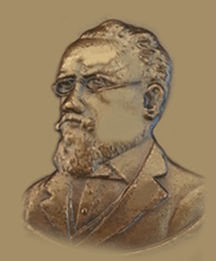
Thomas Stokes, born Taunton, England 22nd March 1831, died Alphington, Melbourne 13th June 1910.
See also http://www.austbuttonhistory.com/7th-may-2023/
Thomas Stokes (1831-1910) came from Birmingham to Victoria, presumably to look for gold, arriving on 2nd January, 1854. Unsuccessful, he returned to his former trade and set up business as a die-sinker. He produced medals, tokens (unofficial pennies and half-pennies used due to a shortage of official coinage), buttons and silverware in Mincing Lane.This lane no longer exists, as outlined in the below article.
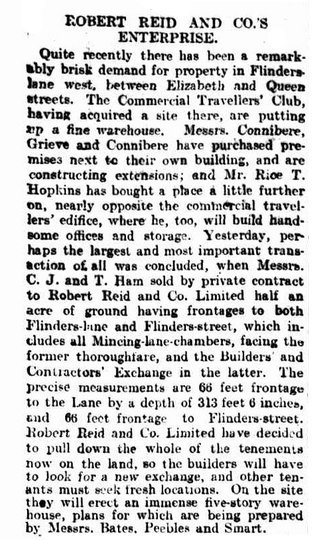
The Age (Melbourne), 7th March 1908 page 12.
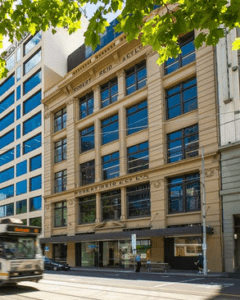
The Robert Reid Building, on the former site of Mincing Lane.
This lane ran between Flinders Street and Flinders Lane in the block between Queen and Elizabeth Streets. Stokes moved to 115 Flinders Lane east by March 1856.

The Argus, 28th August 1854 page 5. Possibly the first reference to Stokes die-sinking, although he’s not named. Alternatively, ‘The Kangaroo Office’ may have produced the button, but would have needed a die-sinker like Stokes to produce the die. He did produce at least one die for them.

The Argus (Melbourne) 4th October 1855 page 7. The Mincing Lane address consisted of one room. At this stage Thomas worked alone.

The Argus (Melbourne), 31st March 1856 page 3. In May he advertised as ‘cutting wood letters for large posters’, and wanting an apprentice.

The Argus (Melbourne), 11th November, 1856 page 3.
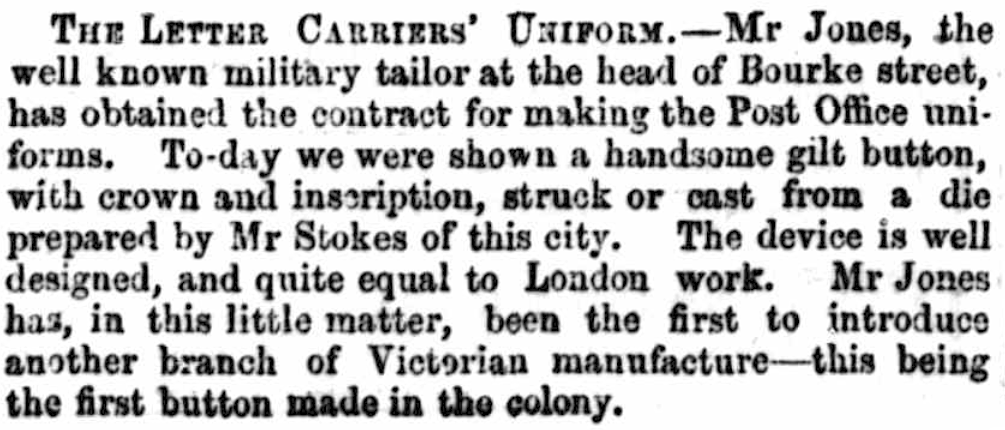
The Age, 18th February 1857 page 4. The Age writer was attributing the start of the industry to the tailor, which annoyed Thomas; see below!
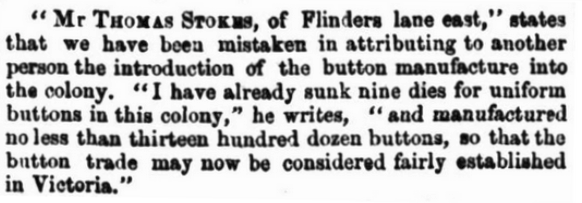
Published in The Age (Melbourne), 19th February 1857 page 4.
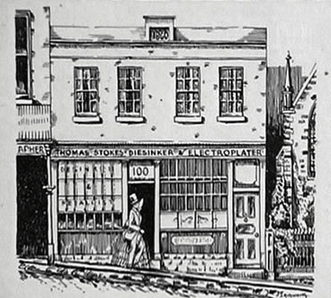
From Stokes Badges website.
Above: The Thomas Stokes (later Stokes and Martin) business was at 100 Collins Street East, Melbourne from around May 1858 until 1881. This building was sold in 1881.
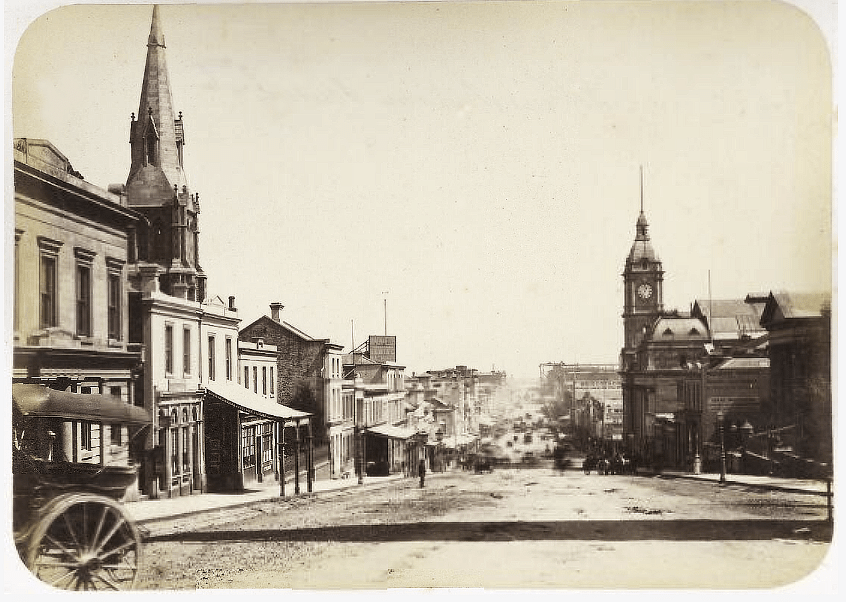
National Library Australia: pic/8131/4 LOC: Collins St, 1875. The building used by Stokes & Martin is behind the shop with the awning on the left.
The firm moved to 29 Little Collins Street before July and remained there until around June 1888 when the firm moved to the corner of Caledonian Lane and Post Office Place.
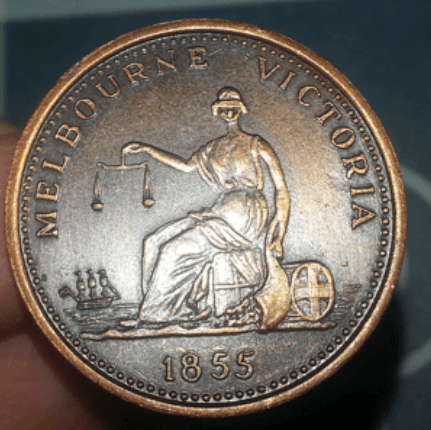
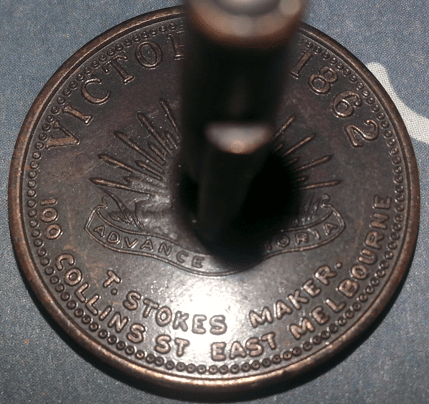
This token dates from 1985 (when he moved to Collins St east) and 1867 (when he went into partnership with Martin).
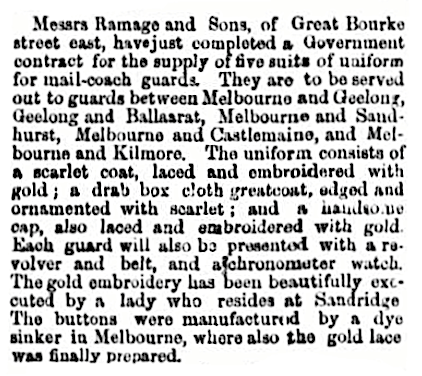
The Age, 16th May 1859 page 6. This is likely to be Thomas Stokes, although he’s not named.

The Colonial Mining Journal, Railway and Share Gazette and Illustrated Record (Victoria), 6th September 1860 page 1.

The Argus (Melbourne), 26th November 1860 page 8.
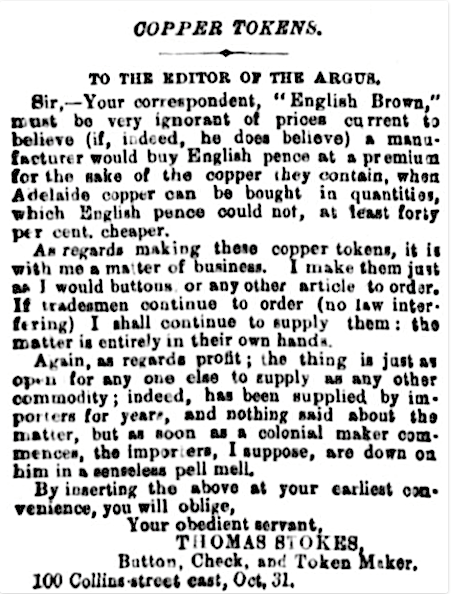
The Argus, 3rd November 1862 page 6: Thomas Stokes had been criticised for his production of traders’ tokens that were used as unofficial currency in British colonies due to a lack of pennies and half-pennies. They were made illegal in 1863 in Victoria.
Around June of 1868 his business was declared insolvent. His tools, stock and plant were advertised for auction as well as land and a timber dwelling. He was able to raise funds to get out of trouble, and by December he was applying for the ‘certificate of discharge’ of his debts. The business would continue at the same address as before the insolvency.
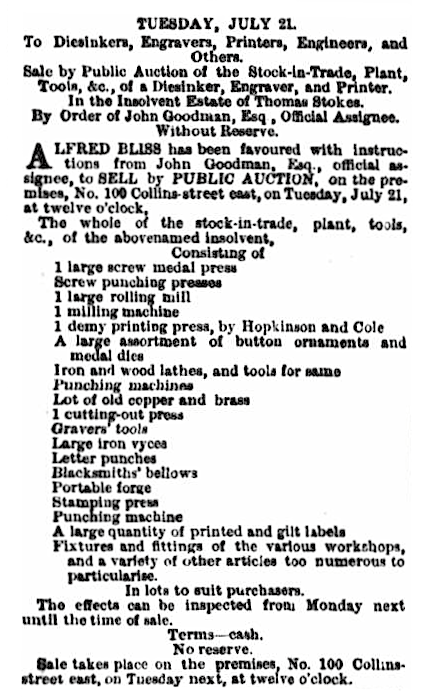
The Argus (Melbourne), 17th July 1868 page 2.
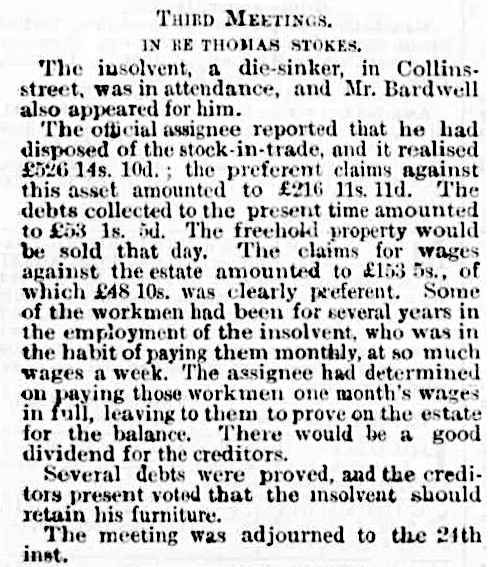
The Argus (Melbourne), 18th August 1868 page 1 of supplement.
‘Stokes Maker’ buttons
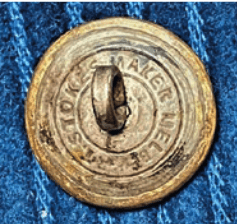
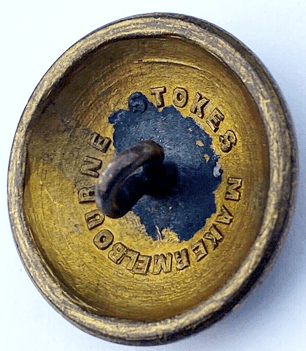
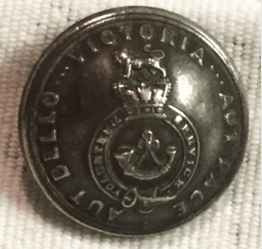
Victorian Volunteer Service: ?1870-80

Stokes Maker (pre Stokes & Martin partnership)
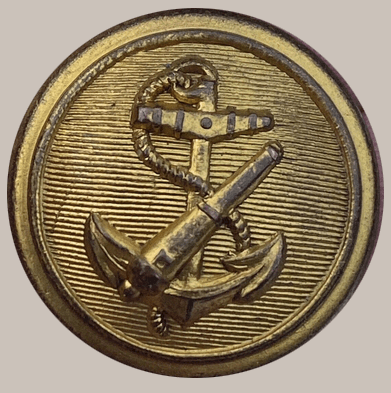
Victorian Naval Artillery
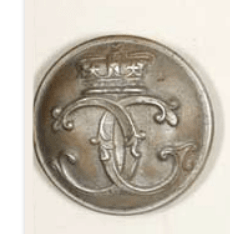
City Guards (Hobart)
Stokes and Martin
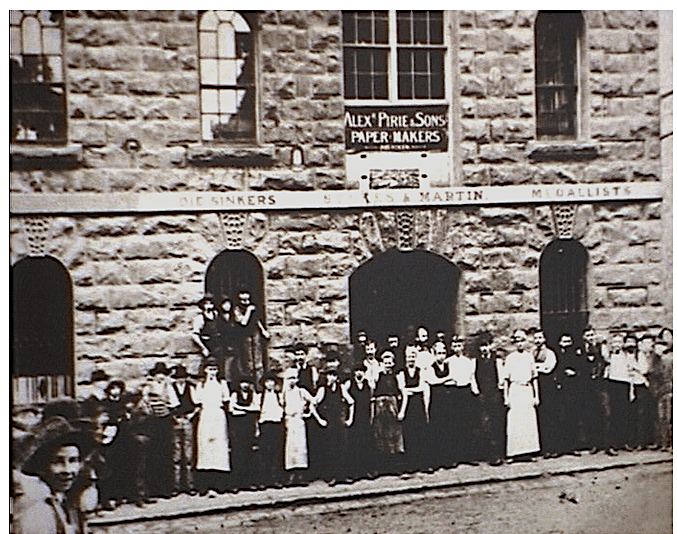
From the Stokes Badges website.
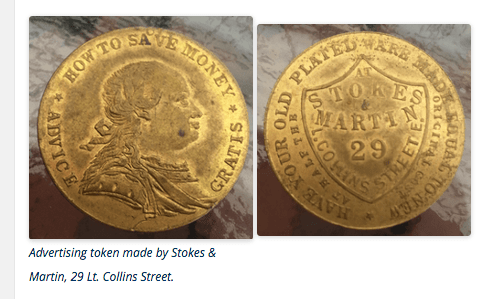
Token dating 1881-88.
Stokes was in partnership with George Frederick Martin from around 1867 (see the medallion below), around the period of his insolvency, until some time (perhaps in 1893) after 1891 when a fire originating in their machinery department destroyed the business premises in Caledonian Lane. (The building ran between Little Bourke Street a.k.a ‘Post Office Place’ and Bourke Street. The address was referred to as 246 1/2 Post Office Place).
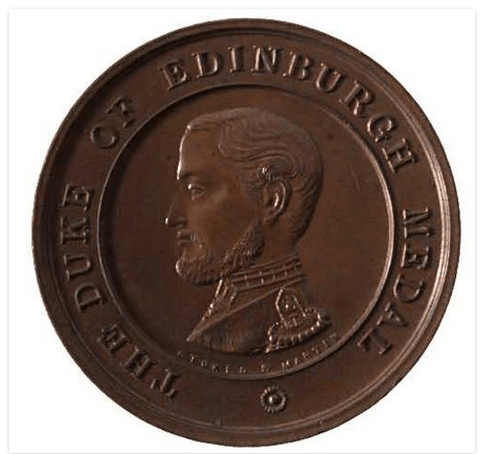
In Museum Victoria’s collection: Medal to commemorate the visit of Prince Alfred to Australia in 1867. The words “Stokes and Martin” can be seen in small print under the bust.
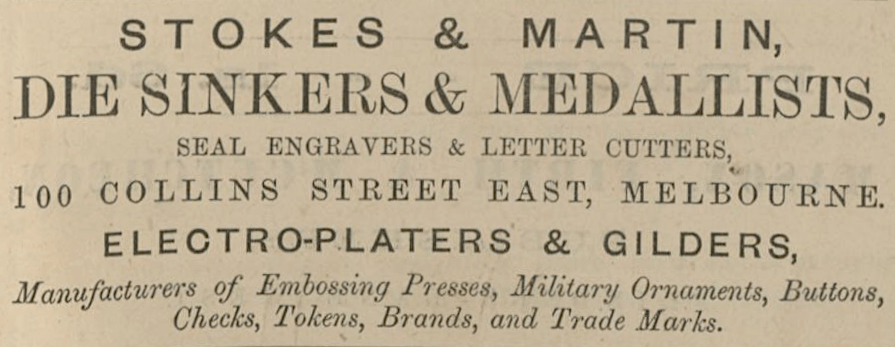
Victorian Almanac for 1875, advertisments page xxvii
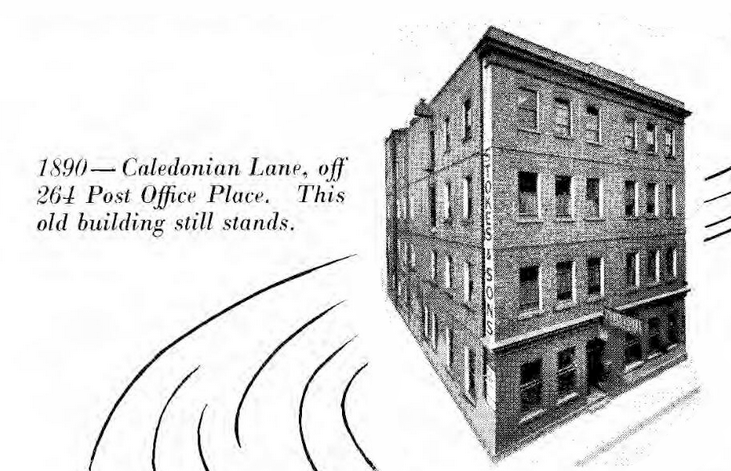
From “The Fine Art of Selling Silverware” complements of Stokes and Sons,1950.
They were not insured, and suffered losses estimated around £15,000. According to differing sources, either because Martin had not renewed the fire insurance, or because of the recession that occurred in Melbourne in the 1890’s, the partnership was dissolved. According to the Powerhouse Museum in Sydney this was in 1893. This could be correct as in July 1893 Stokes and Martin advertised that they had signed all their estate over to trustees for their creditors. In 1892, there was a report of a trial connected with fraud conducted against a bank of which Martin’s brother, Charles R. Martin, was a director. In that, it was revealed that Stokes & Martin had owed that bank 4,000 pounds and that Charles had personally loaned the firm money, showing the financial difficulties they were experiencing. Although mention of a robbery at the premise of ‘Stokes and Martin’ was reported in 1898 in multiple newspapers, this was presumably in error, using the firm’s old name.
George Martin had come to Australia in 1852 and died in 1912, aged 82 years. He was a member for the Malvern Shire Council from 1882-8.
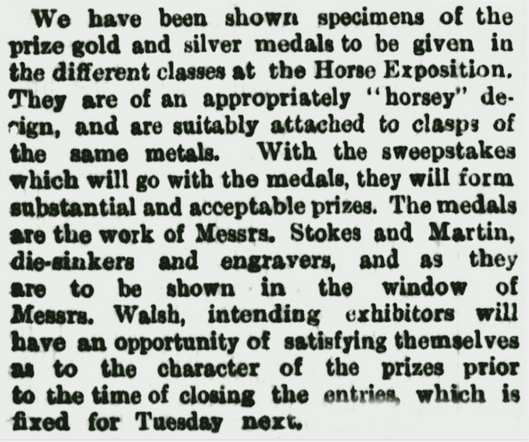
The Argus (Melbourne), 22nd October 1870 page 4.
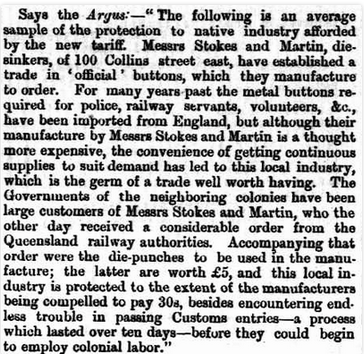
The Ballarat Star (Victoria), 11th October 1871 page 2.
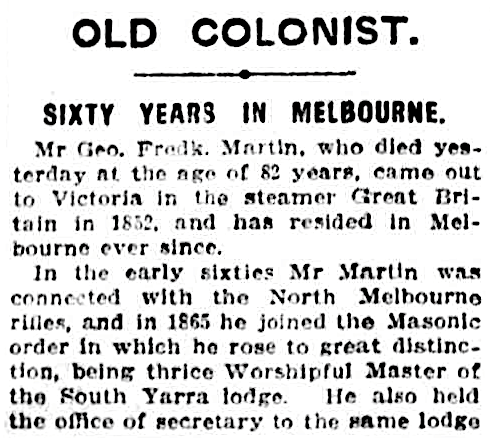
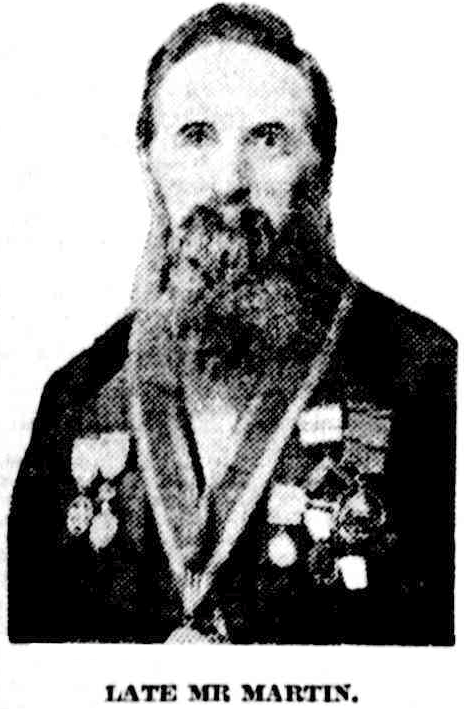
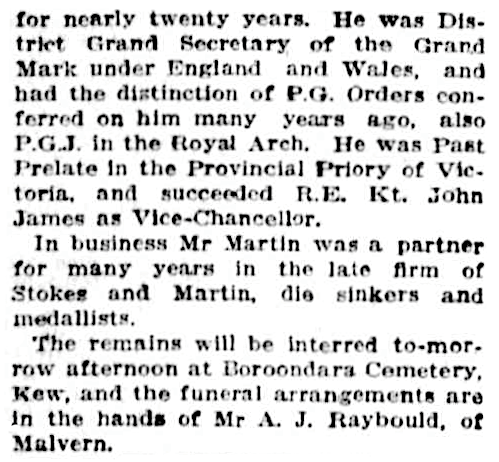
The Herald (Melbourne), 8th March 1912 page 6.
Stokes & Martin Buttons
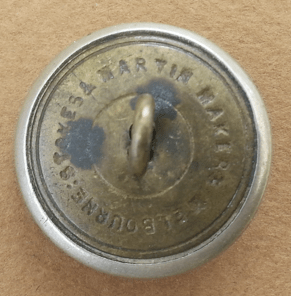
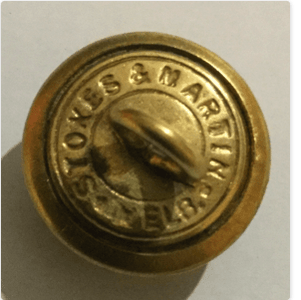
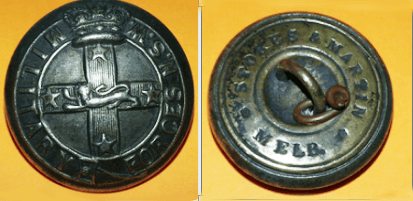
N.S.W. Military Forces uniform button.
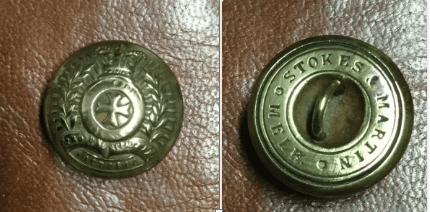
Victorian Volunteer Cadets Corps.
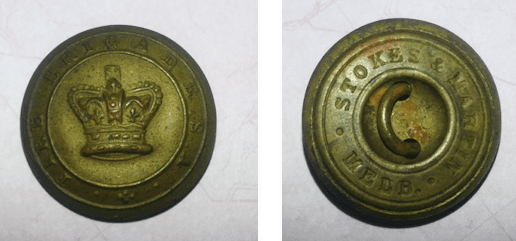
South Australia Fire Brigade.

NSW Military Forces

Lords Brassey livery button
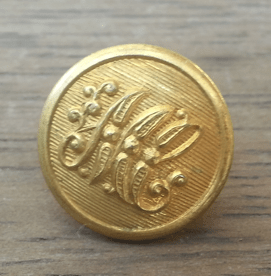
Melbourne Club
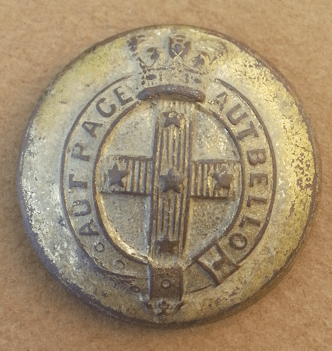
Victorian Military Forces 1880-1893
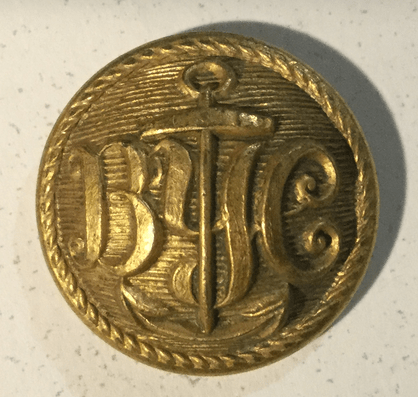
Brighton Yacht Club
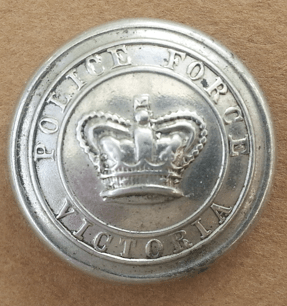
Victoria Police Force pre 1893.

Royal Yacht Club of Victoria
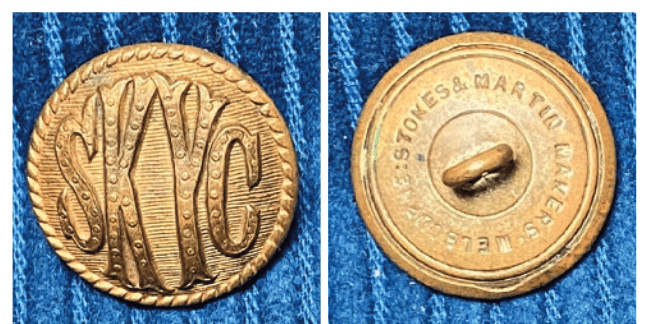
St Kilda Yacht Club
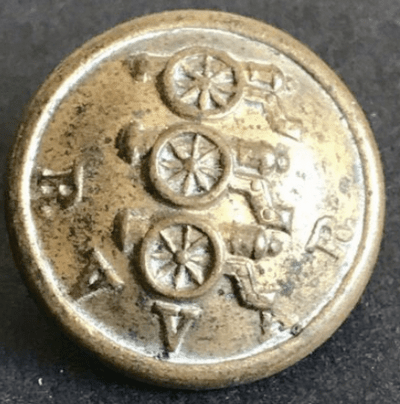
Royal Victorian Volunteers Artillery Regiment
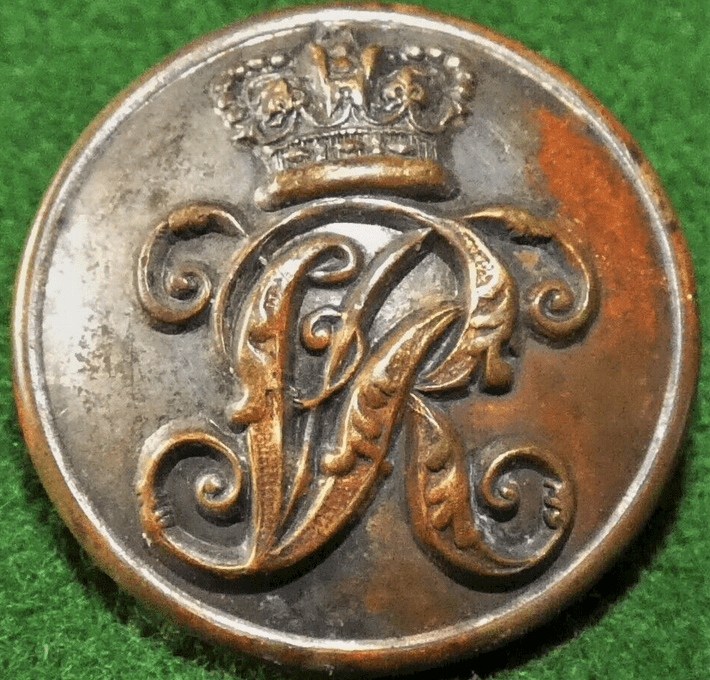
General Service 1870-1901
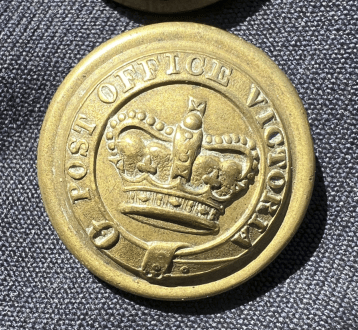
PO Victoria
Examples of the partners’ work as illustrated in newspapers: Unless otherwise noted, these illustrations come from a series of articles entitled ‘A Numismatic History of Australia’ that ran in The Queenslander newspaper in 1895.
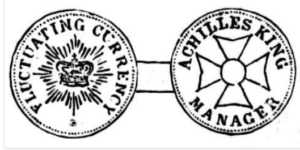
Token issued in the 1860s for use in the Atheneum Club, Melbourne.
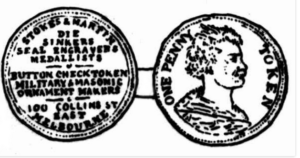
Trade token, around 1858-1862.
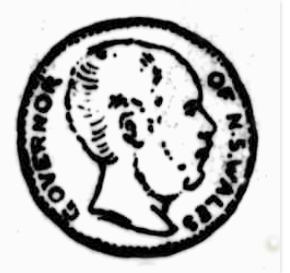
Medallion of Sir Hercules Robinson, Governor of N. S.Wales dated 1877-8
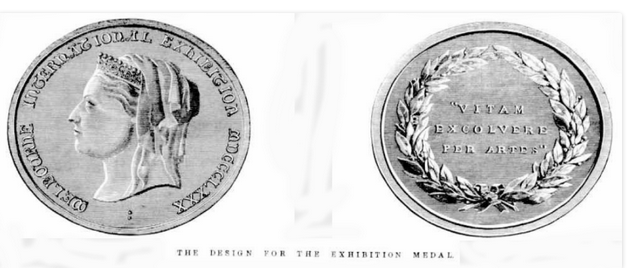
Design of Medals awarded at the 1881 Melbourne International Exhibition. (Published in Illustrated Australian News 6th April 1881 page 77)
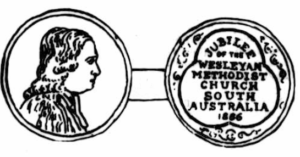
Wesleyan Methodist Jubilee 1886.
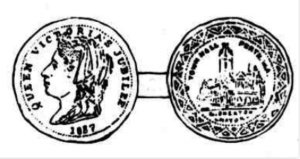
Jubilee medal, “Town Hall Perth W.A.”
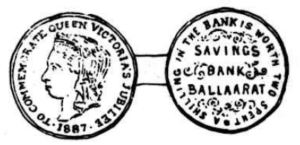
Jubilee medal, ” Ballaarat Savings Bank”

Badge of the Australian Federation league. (Published in Weekly Times, 21st may 1898)
The Sons
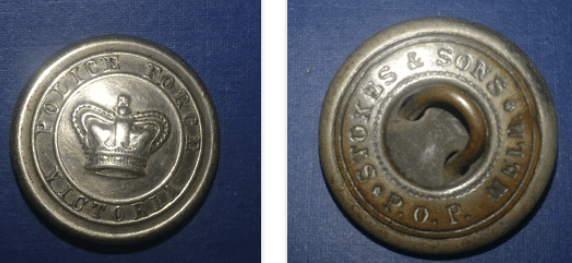
Victoria Police Force pre 1902. P.O.P. address on button back.
Thomas and his wife Ellen had 12 children, 9 of whom survived into adulthood. Of these, Henry Richmond (1861-1919), Frederick Percy (1863-1939), Thomas William (1871-1913) and Edgar Vincent (1878-1932) were involved with the firm. Henry (Harry) joined in 1875, Thomas Jnr in 1886 and Edgar in 1895. Another son, Charles Sydney (1874-1939) was a shipping agent, but not part of the firm as far as I can tell. In late 1893, after the partnership with Martin had dissolved, the firm was renamed ‘Stokes and Son’ (with son Harry as partner) and then the next year as ‘Stokes and Sons’ (Thomas junior also becoming a partner) although the name did not change officially until 1903.

The Age, 21st November 1893. The first record in Trove of ‘Stokes and Sons’.
Another fire considerably damaged the premises in Caledonian Lane (off Little Bourke Street) in 1901. Fortunately, this time they were insured! In 1910 ‘Stokes and Sons’ purchased this building.
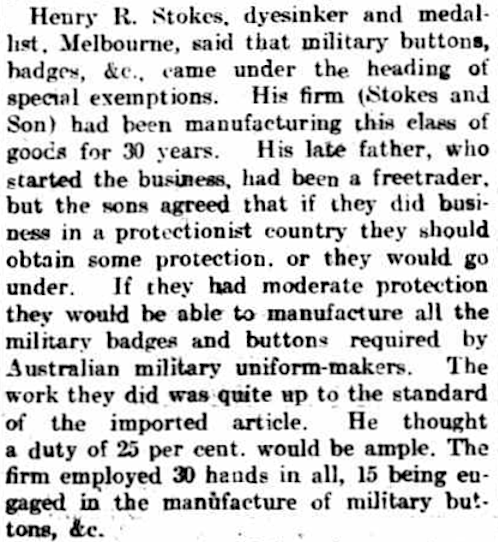
From an article in The Advertiser (Adelaide), 23rd March 1905 about the tariff commission. Despite being described as “late”, Thomas did not die until the 13th June 1910. Perhaps the newspaper meant ‘retired’. His sons Henry, Frederick, Thomas and Edgar followed in the business, as did Henry’s son Russell. Henry died of influenza in 1919, only 9 years after his father.

The Age (Melbourne), 28th May 1919 page 9. Henry died of influenza in 1919, only 9 years after his father.
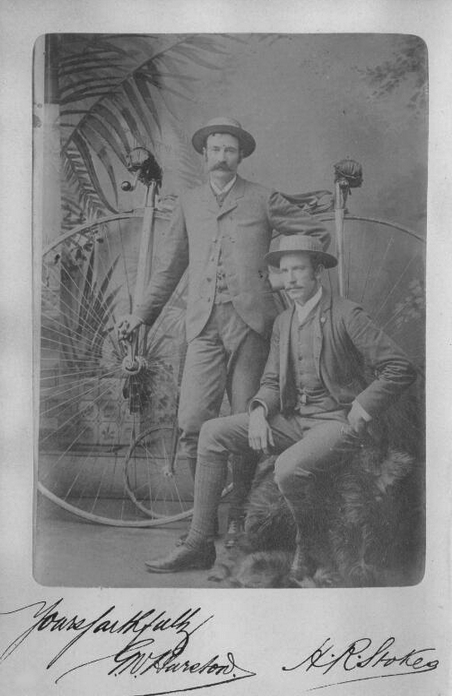
From ‘Round about the world on bicycles : the pleasure tour of G.W. Burston and H.R. Stokes, Melbourne Bicycle Club, Australia’.
George W. Burston’ courtesy of the State Library of Victoria.
The gentleman on the right is Henry Richmond Stokes (1869-1919), who was a renown cyclist, as was his brother Fred (below).
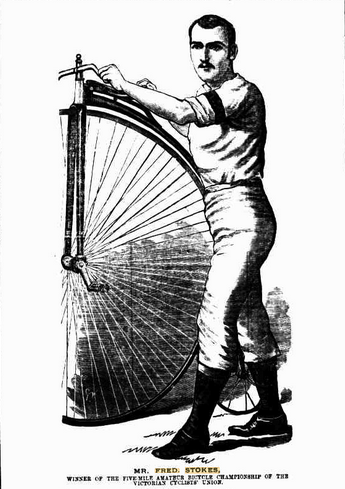
Sportsman, 9th July 1884 page 1.
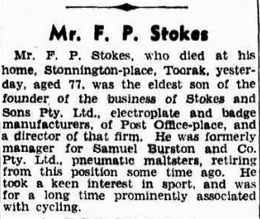
The Age, 21st October 1939 page 28.
Transcription of Obituary of Vincent Edgar Stokes (for some reason his name was sometimes quoted this instead of Edgar Vincent), The Herald 27th September 1932 page 7.
“The death took place yesterday at his home of Mr Vincent Edgar Stokes, principal in Stokes and Sons Pty. Ltd., near Post Office Place. Mr Stokes was widely known among sporting and other clubs as a maker of medals and metal badges. For a long period, he had been contractor to the Victorian Racing Club, the Victoria Amateur Turf Club, the Defence and other Government departments, and was formerly the contractor for the supply of badges to the Melbourne Cricket Club. He has left a widow and family.”
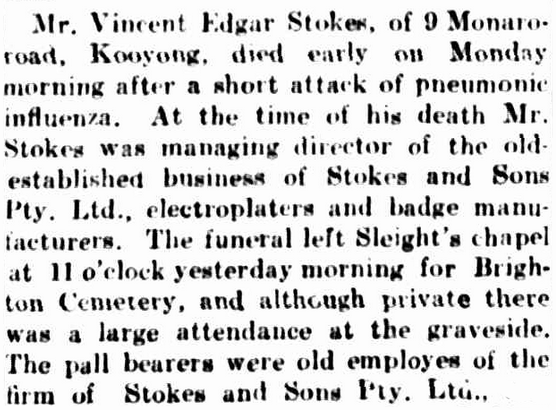
The Age (Melbourne), 28th September 1932 page 9.
1900-1962
Stokes and Sons Pty. Ltd.
The name of the firm changed again in 1911 (after Thomas’s death) to ‘Stokes and Sons Pty. Ltd.’ The mark ‘Stokes & Sons’ appeared on the back of buttons until 1962.
Sydney Branch

Dungog Chronicle, Durham and Gloucester Advertiser, 31st July 1900 page 2.
By 1900 a branch had been opened in Clarence Street, Sydney. It was managed by Thomas Junior. On the 1st February 1913 Mr. Francis Henry Muller became a partner.

Dun’s Gazette 7th April 1913.
After Thomas’s death that year, this branch was offered for sale in December 1913, with Muller becoming the sole operator.

Dun’s Gazette 15th December 1913.

Dun’s Gazette 2nd February 1914.
The name was changed to Sterling Plating & Manufacturing Company on the 3rd February 1915.
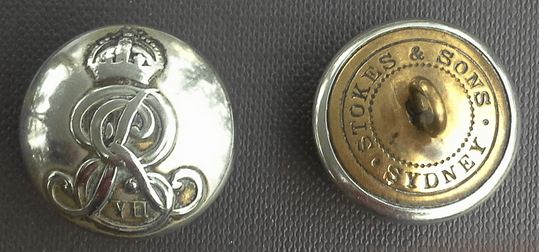

Melbourne Branch
In 1906 the firm won a tender for military buttons for Tasmanian and New South Wales Forces. The prices ranged from 25 shillings per gross for gilt buttons, to 2 shillings, 3 pence per gross for brass buttons. Thomas Stokes died on the 13th June, 1910. Below is one of the many contracts for military buttons to be found in the Commonwealth Government Gazettes.
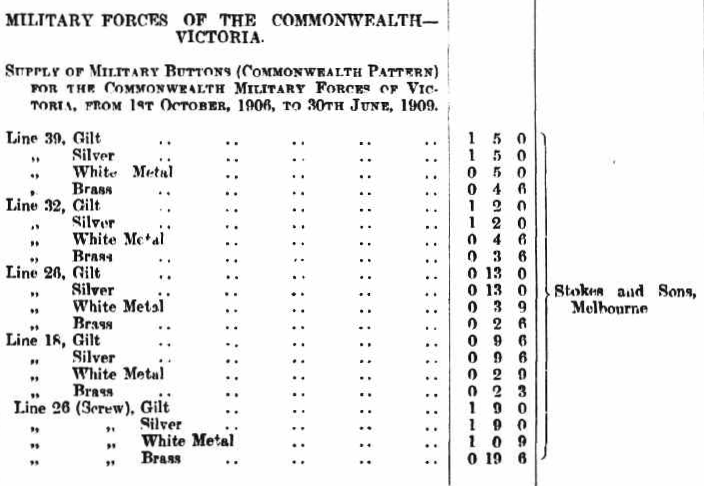
Commonwealth Gazette, 8th December 1906 page 1522.
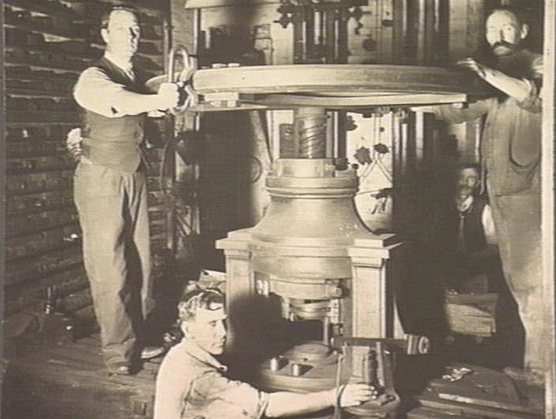
IN MUSEUM VICTORIA’S COLLECTION: A medal and coin press in use at Stokes & Sons, Melbourne, circa 1907. This press had belonged to J. W. Taylor and used at the great Exhibition in London in 1851. It was brought to Australia in 1853 by Reginald Scaife for the Kangaroo Office venture (Australia’s first private mint) and used to mint the 1854 Melbourne Exhibition medals. Thomas Stokes purchased the press from Scaife in 1857, using it until it was scrapped in the 1930s.
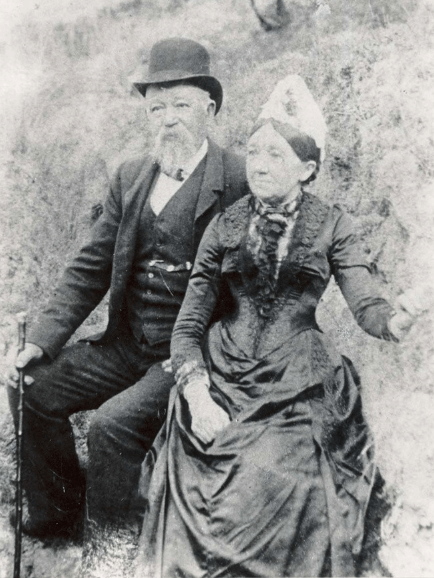
Thomas and Ellen Stokes. According to the website, this photo dates c.1880s. This is probably incorrect, as that would date Thomas only in his fifties. I would hazard that it was taken in the early 1900s by his white beard and hair. Ellen died in 1906. (Originally from Darebin Library.)

The Sydney Morning Herald, 15th June 1910 page 8. Thomas jnr was running the Sydney branch at the time of his father’s death, therefore placed a notice in a Sydney newspaper.
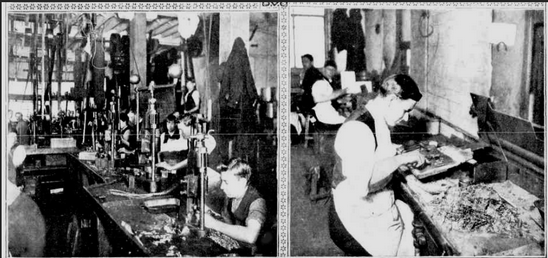
The Australasian, 18th September 1915 page 25. “War Activities in Melbourne”. Hand presses cutting out badges and buttons (Stokes and Sons).
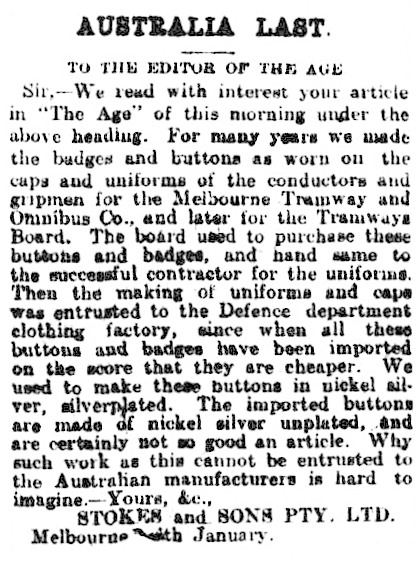
The Age, 25th January 1927, page 10.
The Firm moves to Brunswick
In 1935 the firm moved to new premises in Brunswick (although they maintained a depot in Caledonian Lane until 1953 at least). Several grandsons, Russell, Harry, Eric and Tom, would join the firm.
In this year there was a Parliamentary Inquiry into lowering certain tariffs, including metal badges, and buttons. Russell H. Stokes protested that the relevant tariff should actually be increased by 10%, rather than lowered. He stated that even with the current levels of protection local firms found competition ‘keen’ with imports, as labour costs were higher than in the United Kingdom and the Continent. The board were not persuaded, as the local trade was ‘only a minor industry’. The firm employed 280 people in 1939.
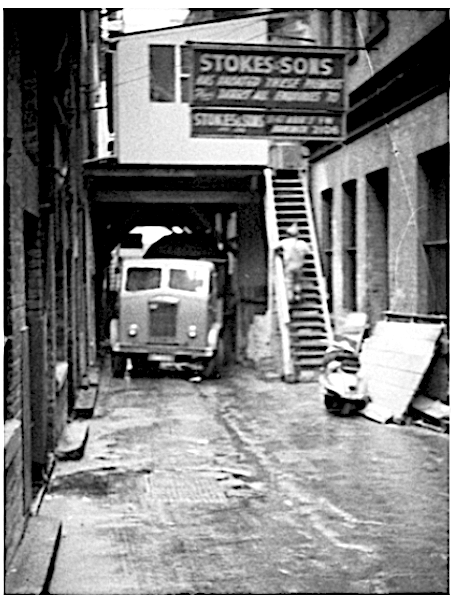
From the ‘City of Melbourne Collection’ depicting a lane with a sign informing that Stokes has moved. This would be Caledonian Lane. The firm moved in 1935. See http://citycollection.melbourne.vic.gov.au/35a-29l-image-of-a-lane-with-a-sign-for-stokes-sons/
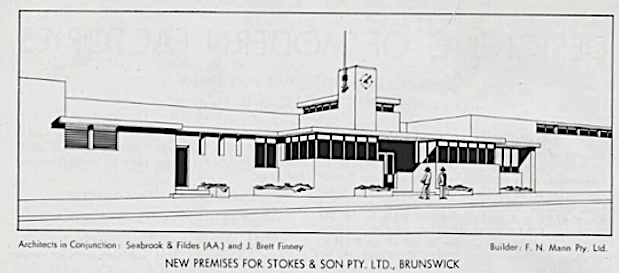
Journal of the Royal Victorian Institute of Architects., v.33, no.6, 1936
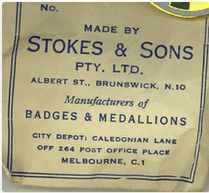
From the Federation University Australia Historical Collection.
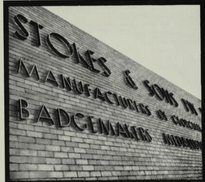
1956 Article
This article was originally printed in the magazine ‘Factory and Plant”, September 1956, and reprinted in the National Button Magazine in the July-August, 1973 issue. It explained that the firm had outgrown the facilities in Brunswick, and had moved to Ringwood.
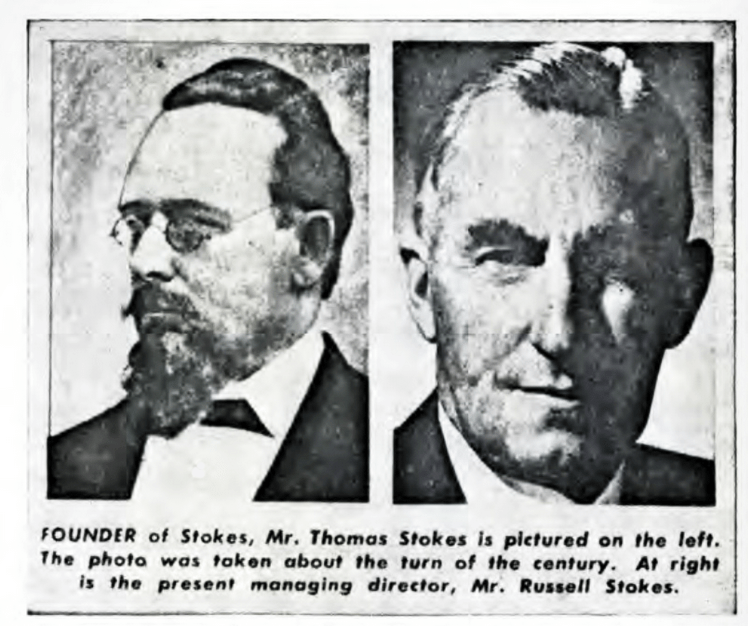
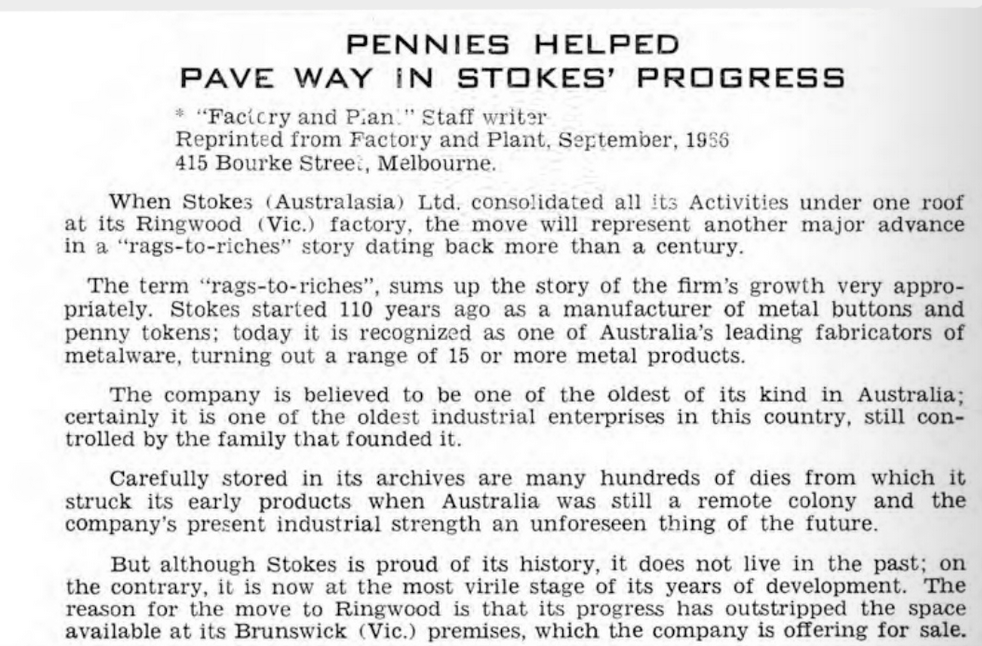
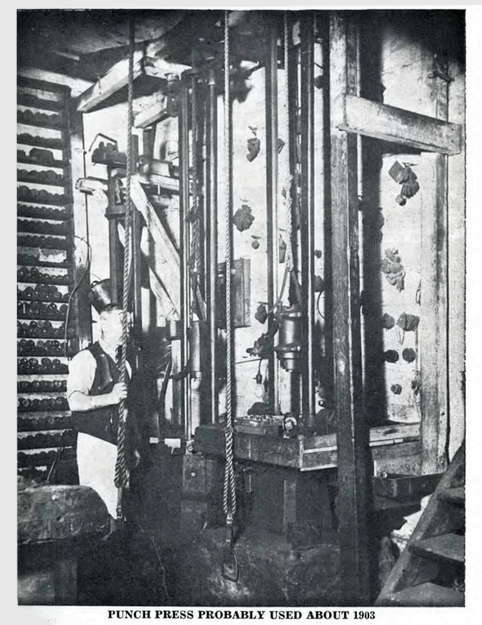

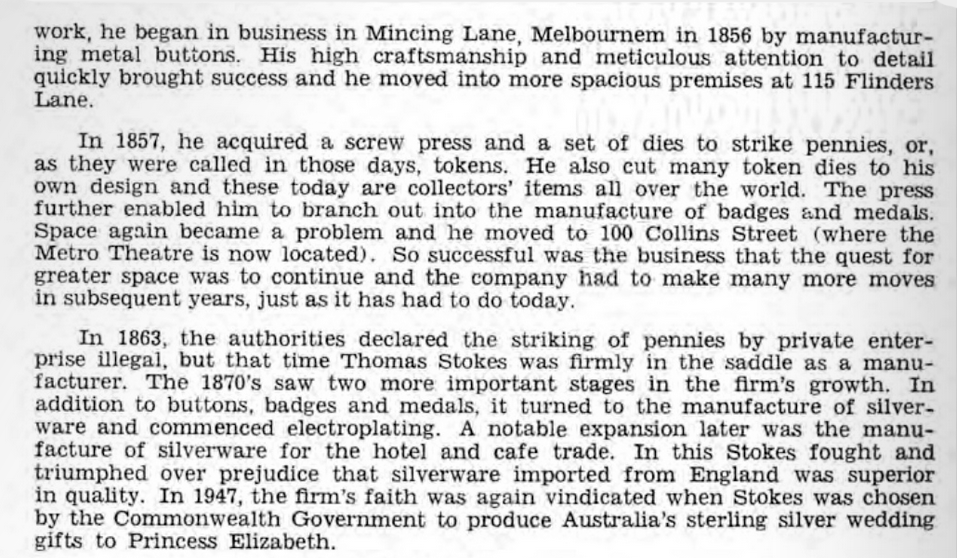
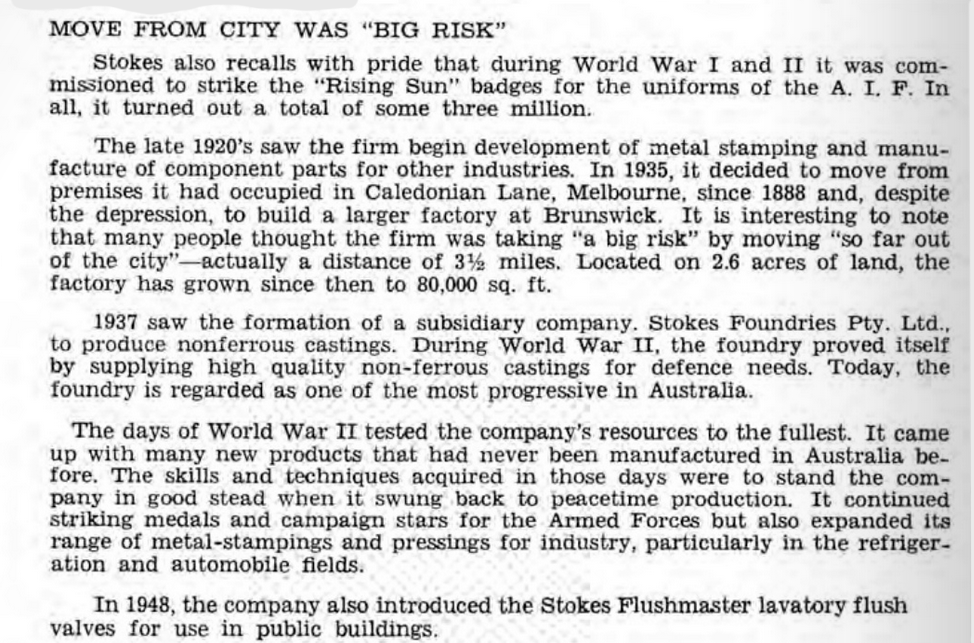

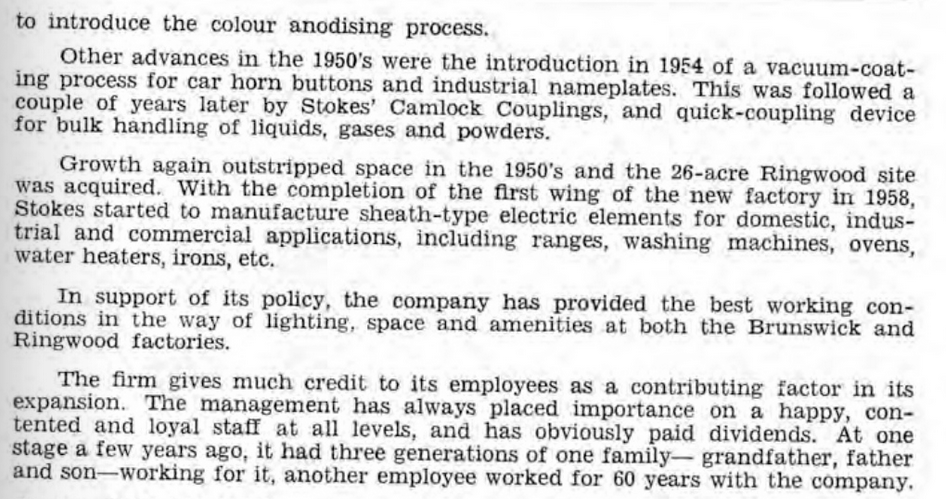
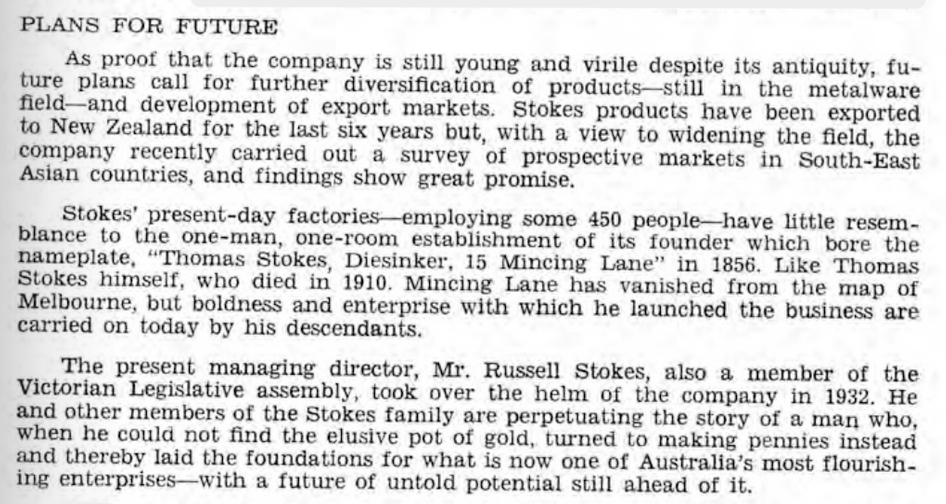
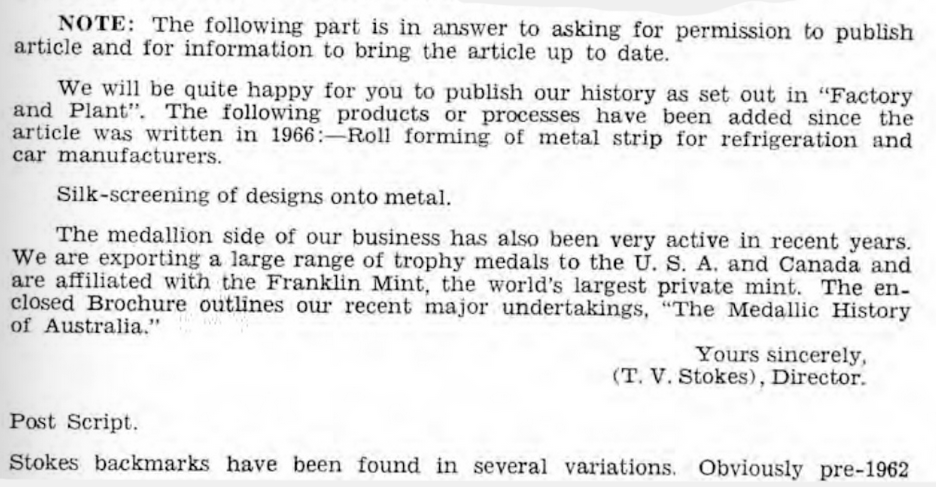
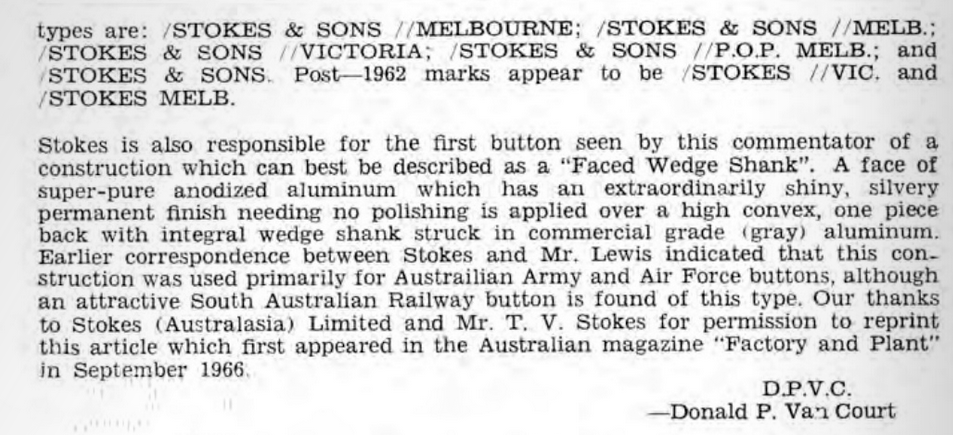
“T.V. Stokes” quoted in the article from 1973 was Thomas Vincent Stokes (b.1916), son of Edgar Vincent Stokes, and grandson of Thomas.
1958 Tariff Report
If you wish to access the complete report: https://nla.gov.au/nla.obj-2772284962/view?partId=nla.obj-2775492965#page/n0/mode/1up
Details regarding Stokes & Sons from the report:
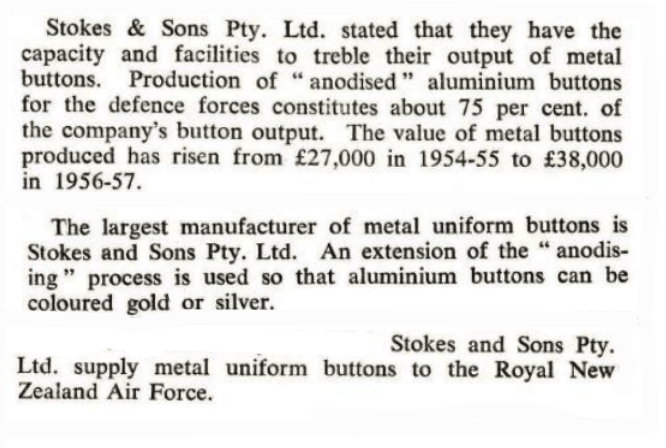
1962 onwards
Stokes (Australasia) Ltd./Stokes Badges
The name changed to ‘Stokes (Australasia) Ltd’ in 1962, with the public listing of the firm on the stock exchange. In 2015 the manufacturing plant (purchased in 1956 and located in Ringwood, Victoria) was closed. However, the button and badge making division had been sold to a N.S.W. company in 2013 (Perfection Plate Holdings) and continued as Stokes Badges. This name is no longer registered by Perfection Plate, but Stokes Badges is still trading, presumably under new ownership.

The Age, 25th May 1939 page 15. “These are the expert employes (sic) of Stokes and Sons Pty. Ltd., manufactures of Georgian silver ware, badges and medals, and die sinkers, who have a modern factory in Albert Street , Brunswick.
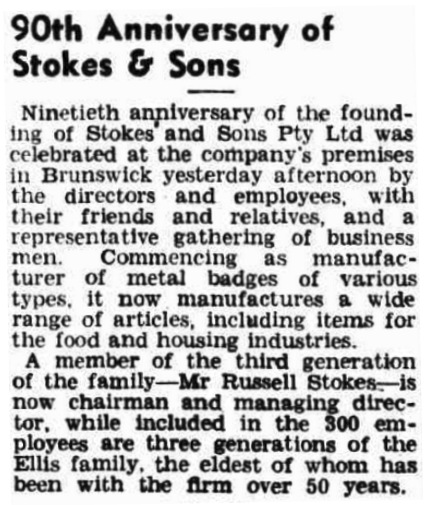
The Argus (Melbourne), 13th September 1946 page 9.
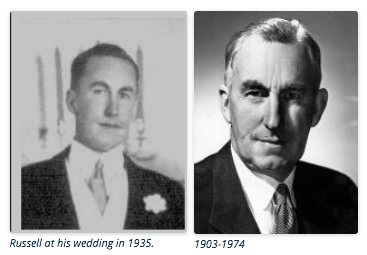
Russell Stokes, grandson of Thomas. He was the managing director and chairman of the company from 1932 (after the death of Edgar Vincent Stokes) until 1974.
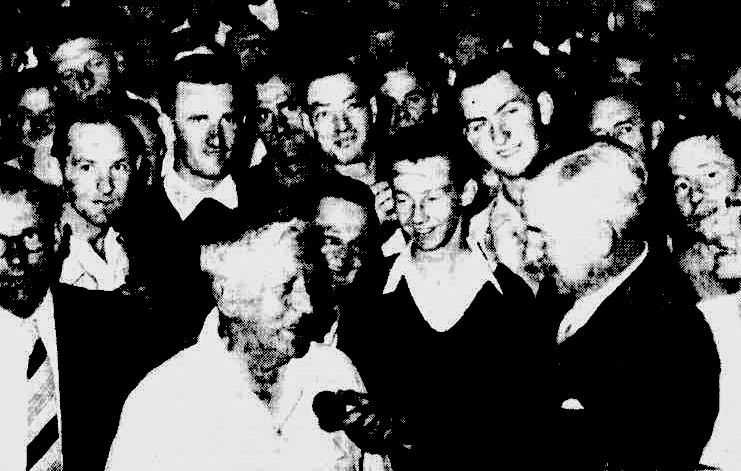

The Argus, 22nd December 1956 page 6.
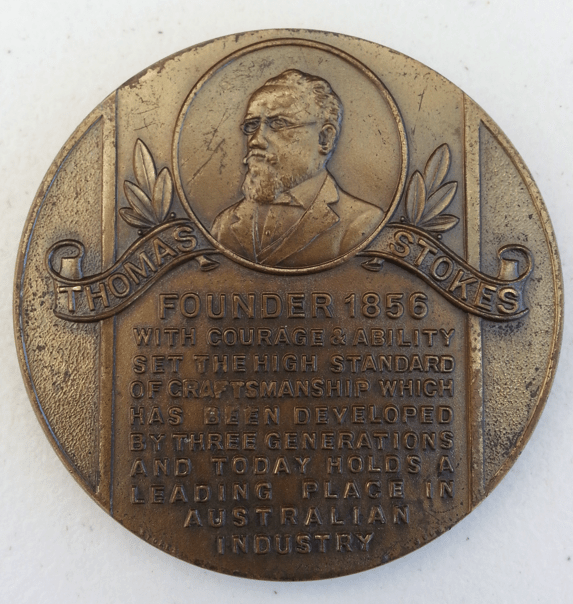
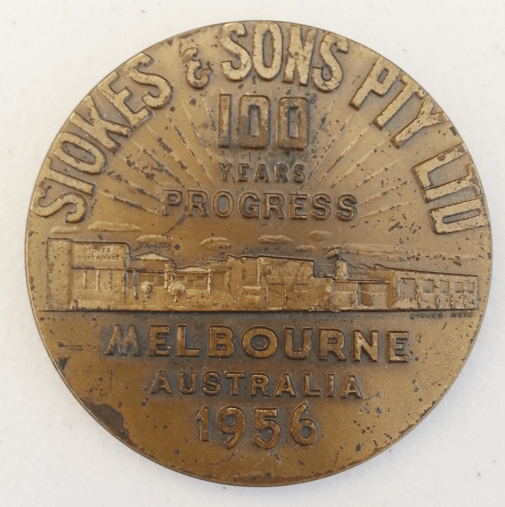
Medallion struck for the company’s centenary.
In The Bulletin, 10th October 1964 page 79, Stokes (A’asia) ran an article spruiking their issue of shares at that time. They were then selling the Brunswick foundry to consolidate at their Ringwood factory. Part of the article is reproduced below.
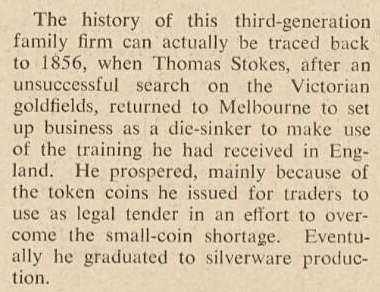
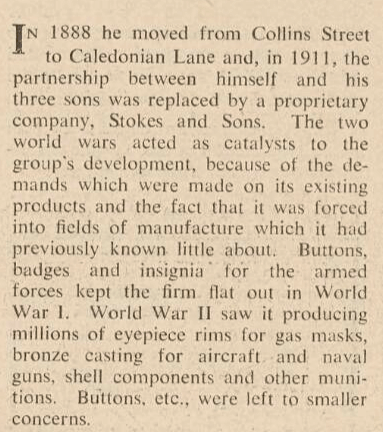
For the whole article, see https://nla.gov.au/nla.obj-685328214/view?partId=nla.obj-685391560#page/n78/mode/1up
The article states that whilst the company produced buttons during WW1, it did not do so during WW2 as it was too busy with other items.
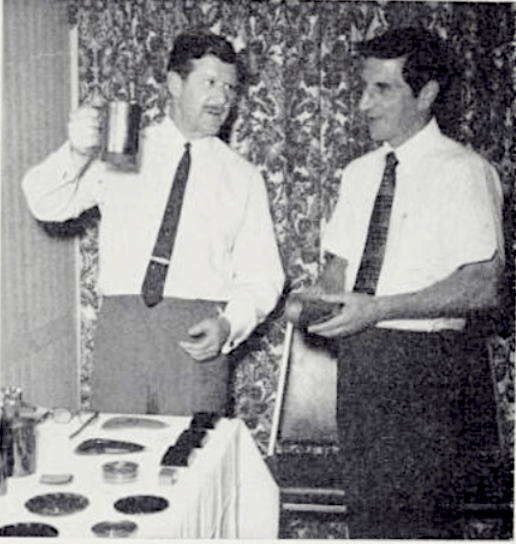
From the journal ‘Imports through the Port of New York’ appendix A, 31st October 1970. “Mr T. V. Stokes, of Stokes (Australasia) Ltd, holds up one of his company’s products for the inspection of Mr C. Siracusa, of Gino’s Trophy Manufacturers, Cleveland.”
Another article was published on 16th March 1974, page 53.
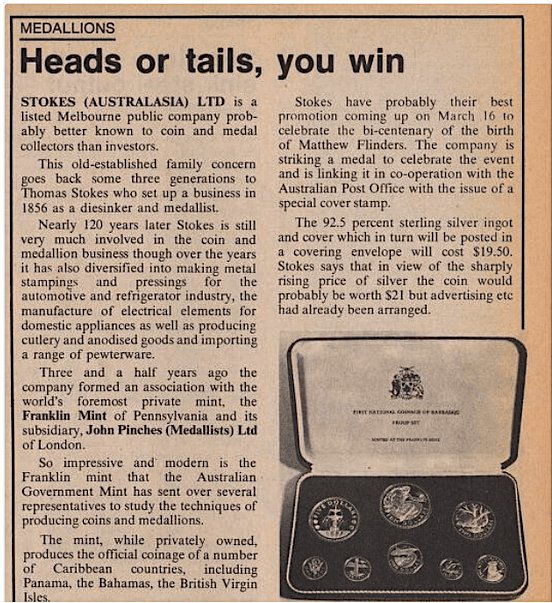
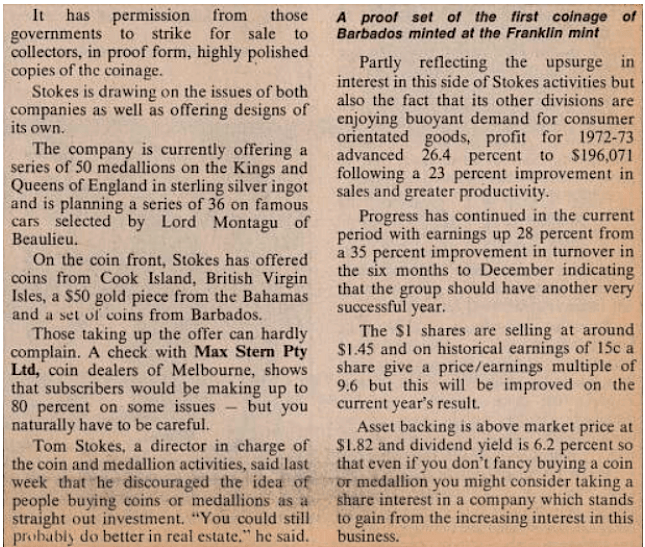
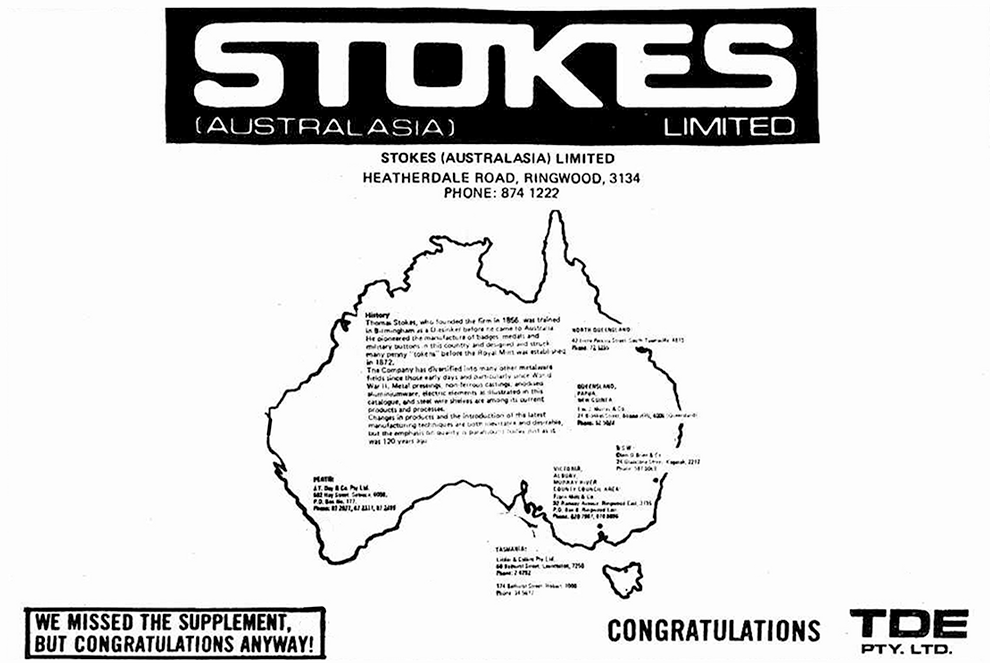
Papua New Guinea Post-Courier (Port Moresby), 30th October 1979, page 7. See magnified insert below.
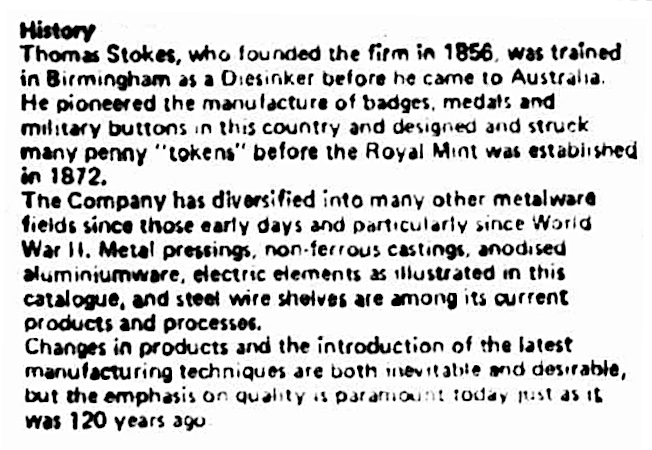
Stokes & Sons/Stokes Buttons
Note that the backmarking of buttons was variable even in a given era. Whilst ‘Stokes & Sons’ indicates pre-1962, some buttons of this era are just marked ‘Stokes’, probably due to size constraints. The use of anodised aluminium and/or two holes punched into the back plate indicates 1953 onwards.
This is by no means a complete collection. Other examples appear in the posts of the website, and more are always coming to light.
Please see the Uniform pages for the many, many, Staybrite aluminium military/cadet buttons produced by Stokes from around 1953 onwards.
http://www.austbuttonhistory.com/uniform-buttons-2/school-buttons/
http://www.austbuttonhistory.com/defence-forces-uniform-buttons/post-world-war-2/
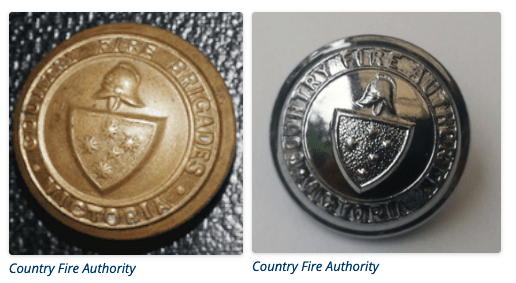
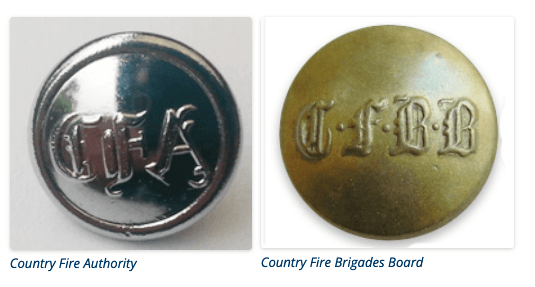
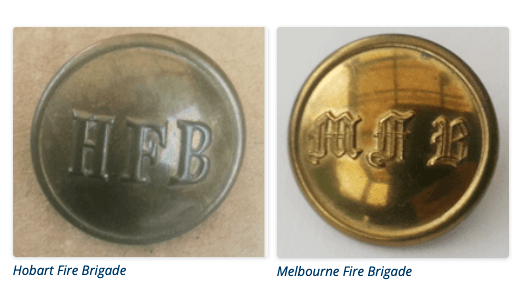
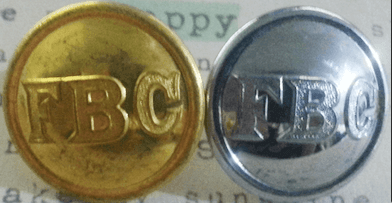
Fire Brigade Commision (Tasmania)
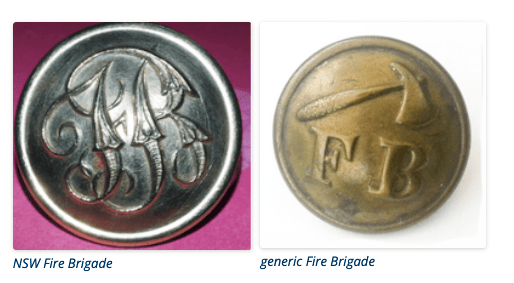
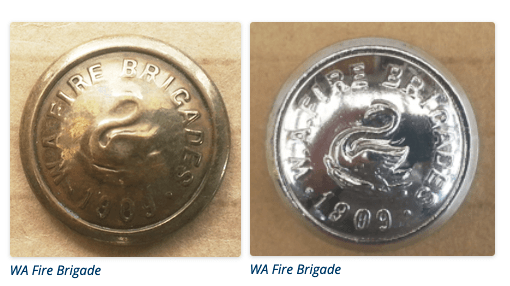
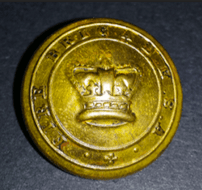
South Australian Fire Brigade pre 1902

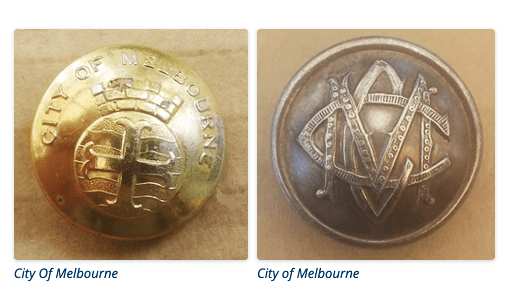
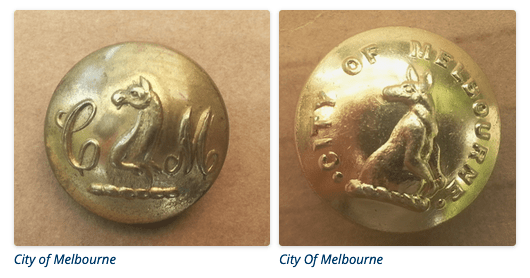
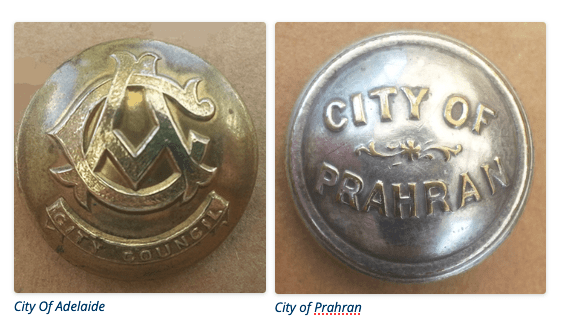
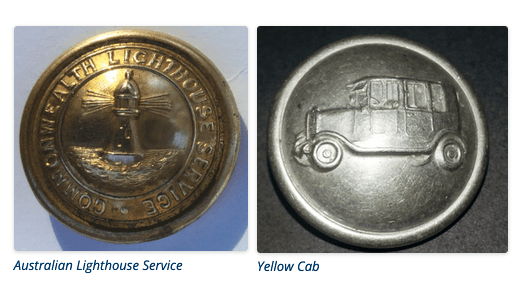
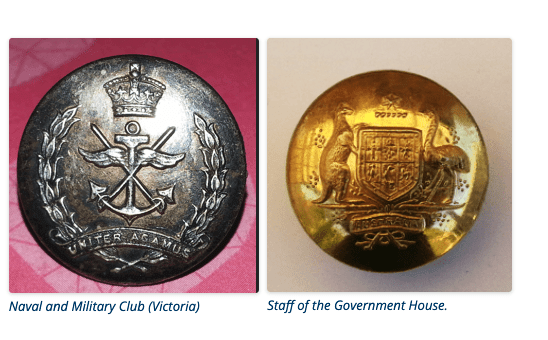
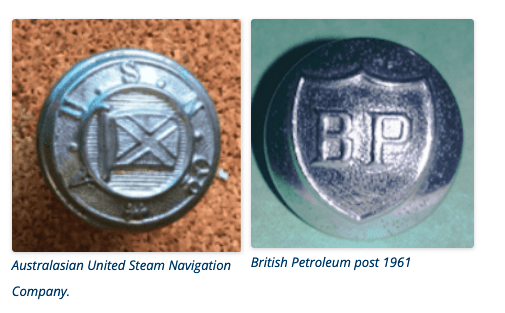
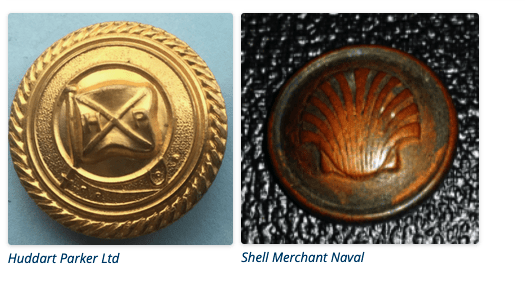
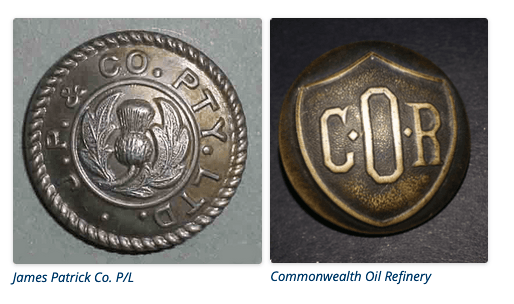
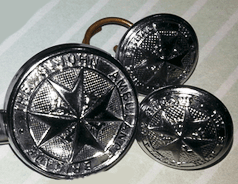
St John’s Ambulance Brigade

St John’s Ambulance Brigade
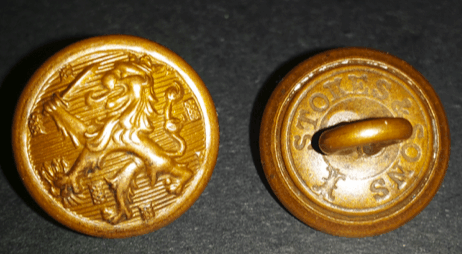
Netherlands East Indies Government in Exile.

? State Electricity Commission.
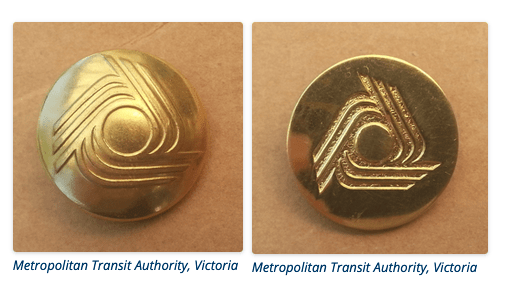
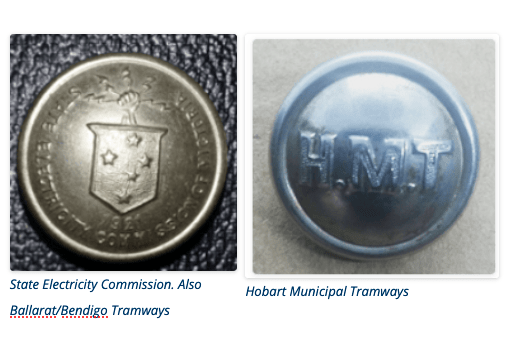
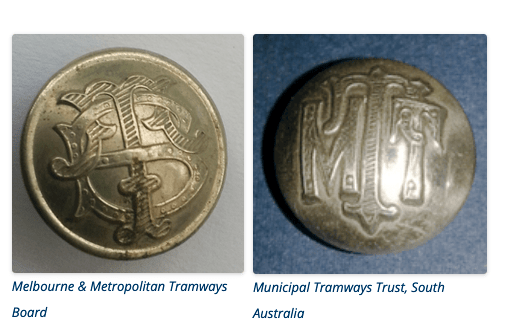
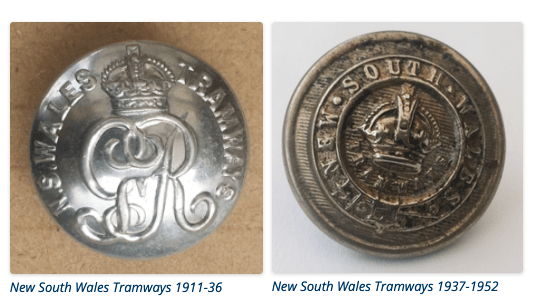
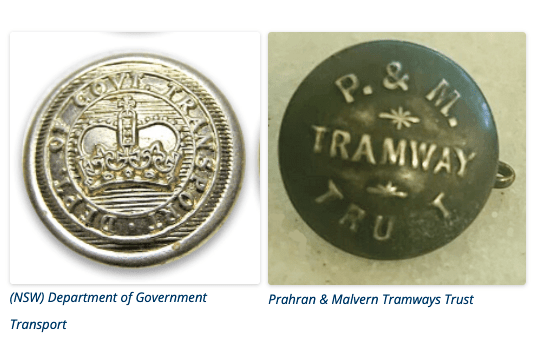
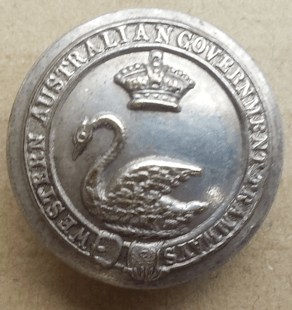
Western Australian Government Tramways
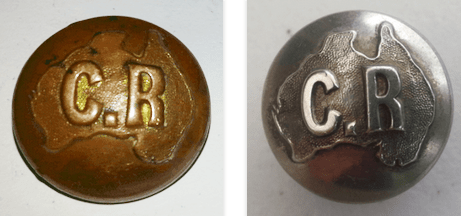
Commonwealth Railway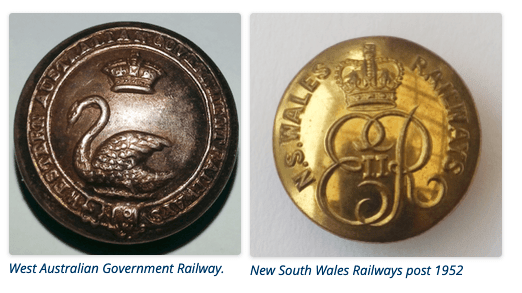
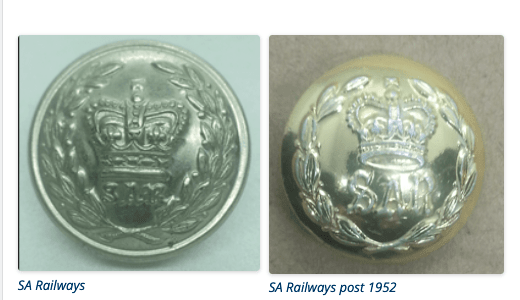
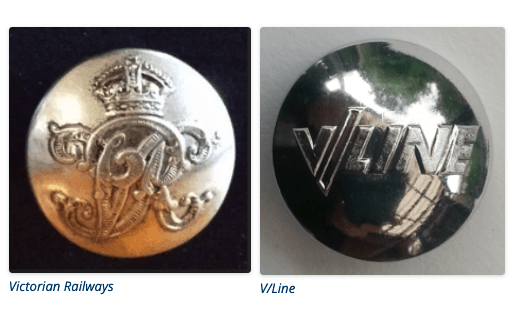
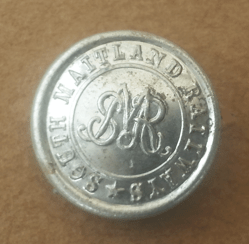
South Maitland Railways
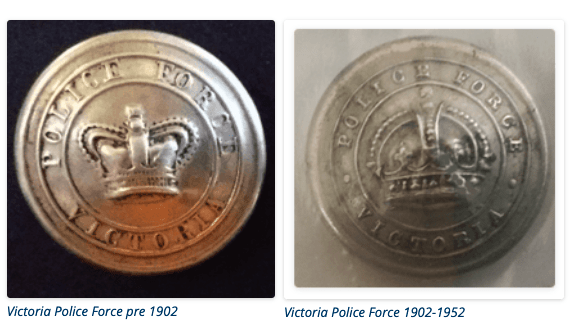
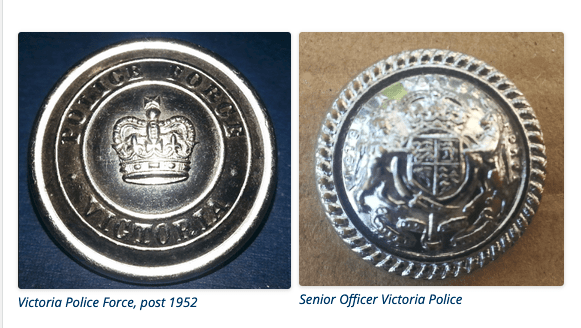

Protective Service Officer, Victoria Police
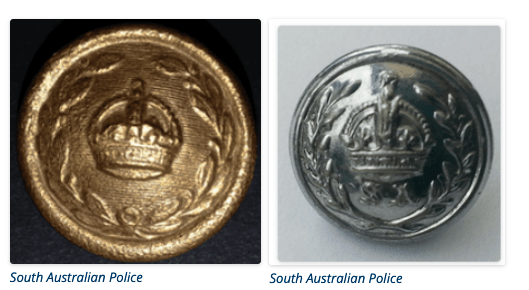
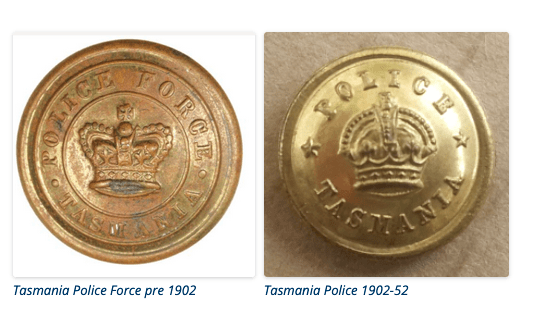
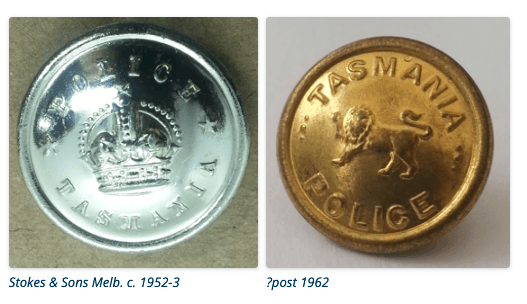
Tasmania Police
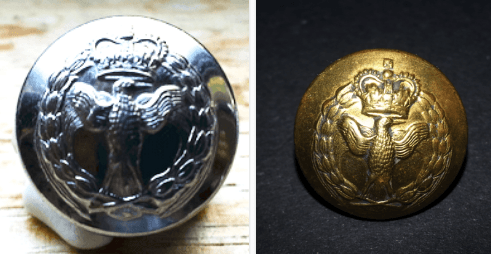
Papua New Guinea Police
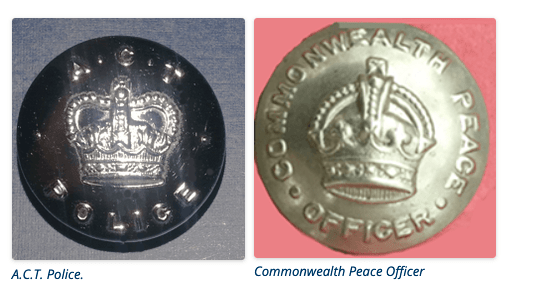
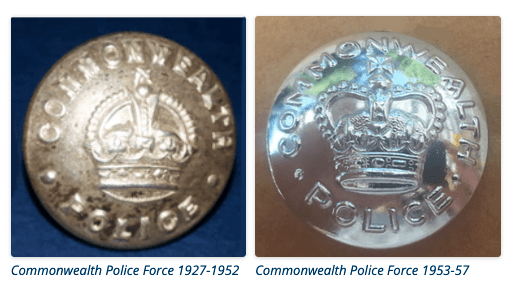
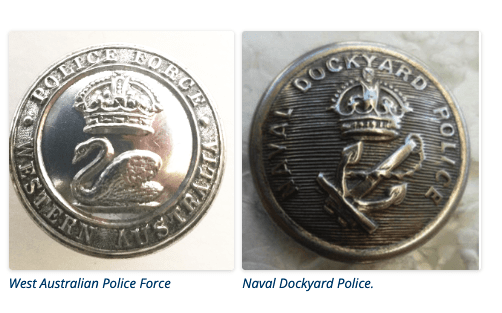
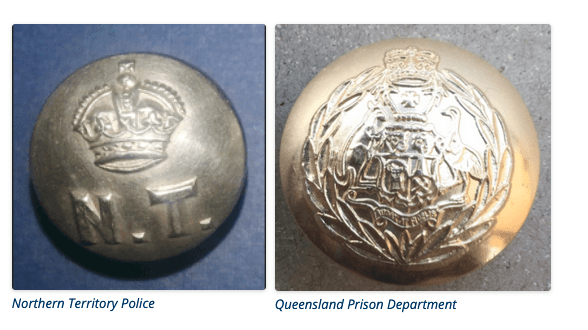
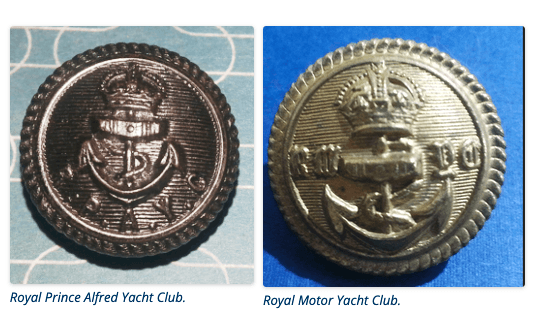
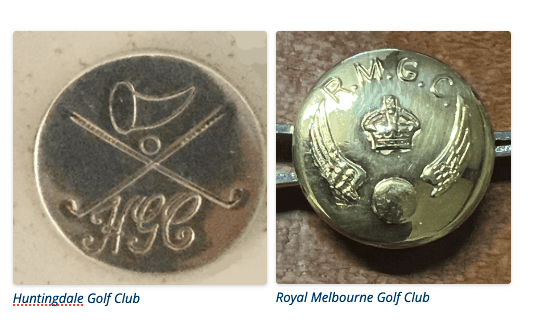

Melbourne Cricket Club
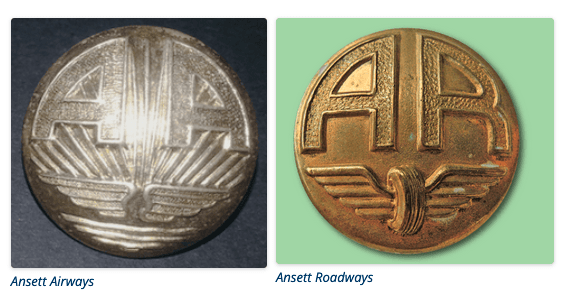
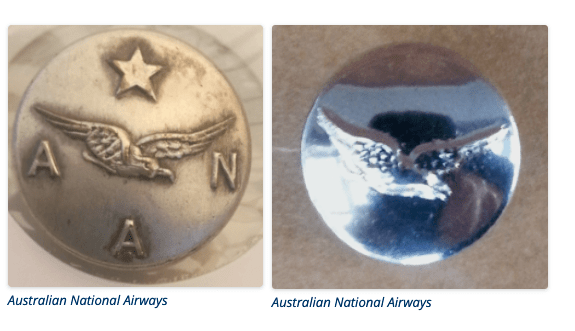
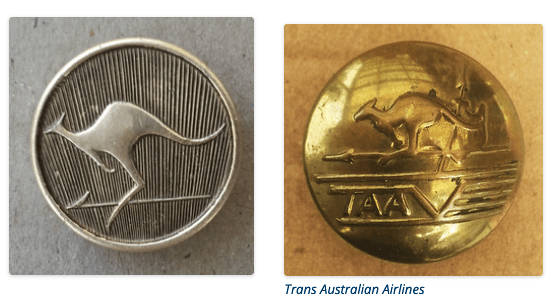
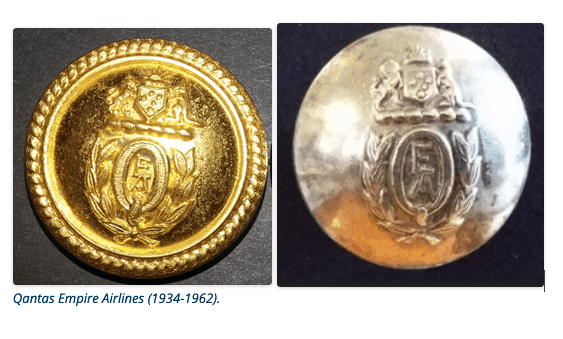
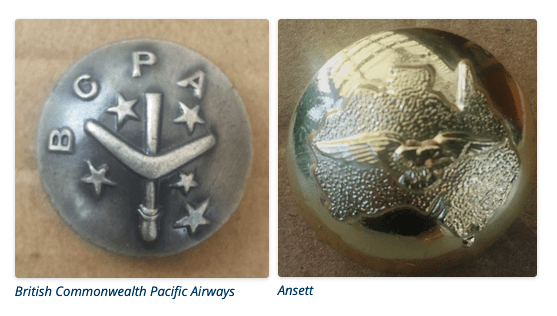

Guinea Airways Limited
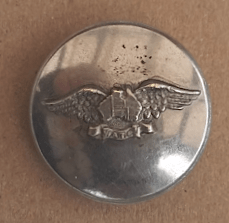
W.A.T.C.
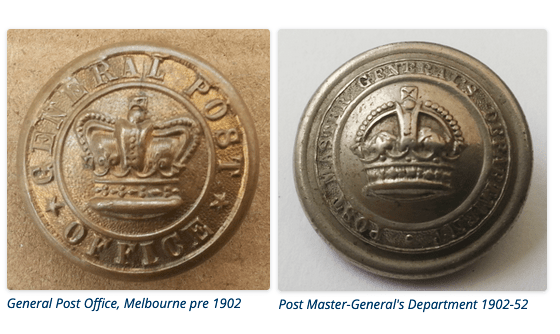
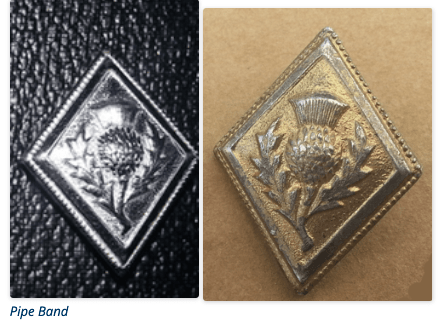
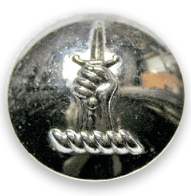
New South Wales Police Pipe Band
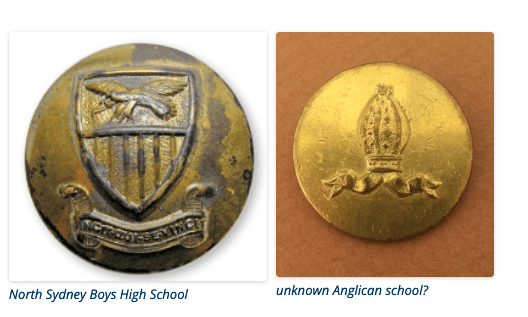
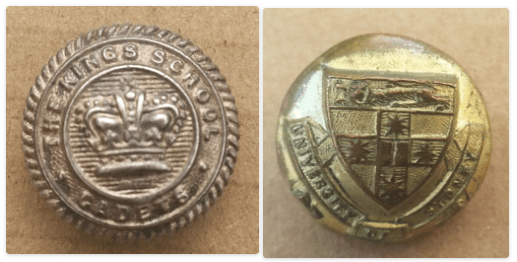
Kings School cadets. University of Sydney
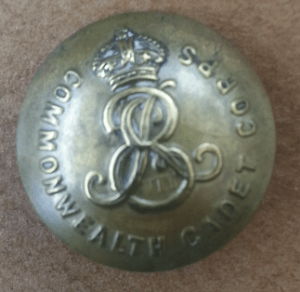
Commonwealth Cadet Corps
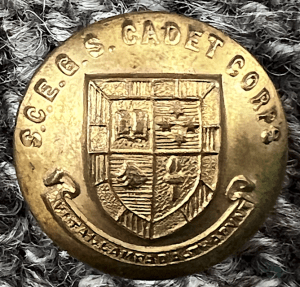
Sydney Church of England Grammar School Cadets
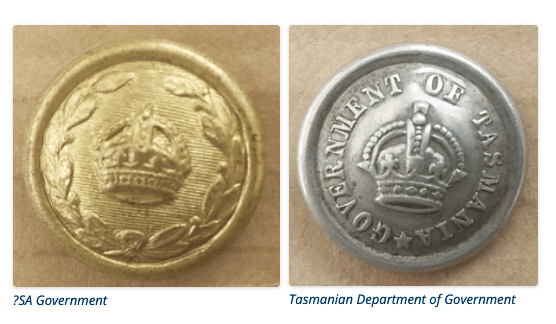
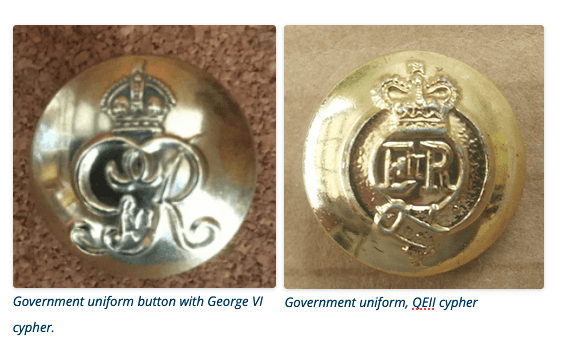
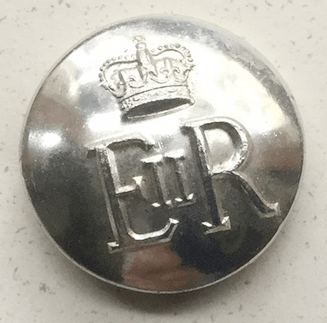
Government uniform, QEII cypher
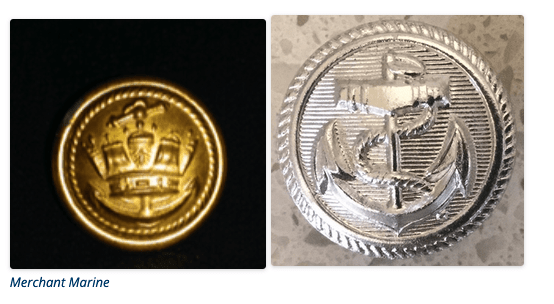
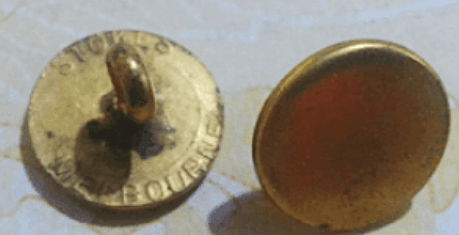
Small (approx.13mm) plain gold buttons
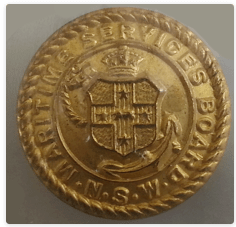
Maritime Services Board of New South Wales
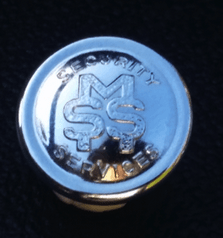
MSS Security
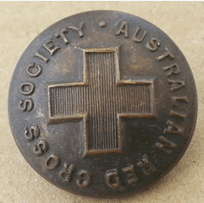
Australian Red Cross Society

Campaigners for Christ Volunteers
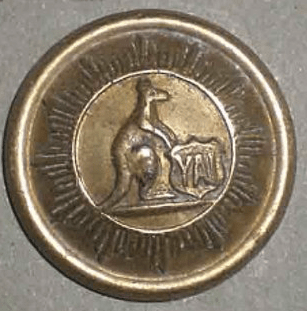
Young Australia League
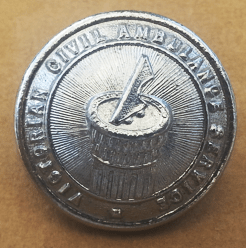
Civil Ambulance Service
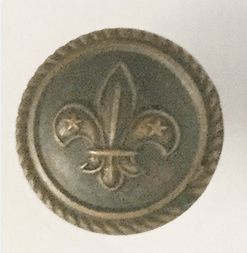
Scouts
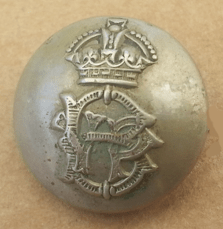
unknown
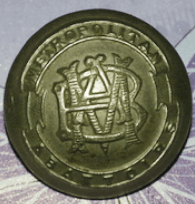
Metropolitan Abattoirs (Adelaide)

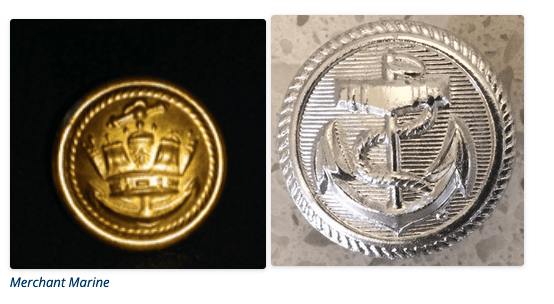
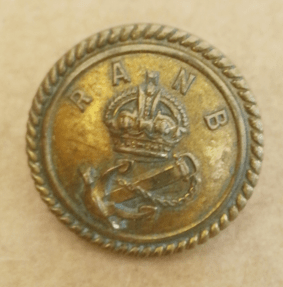
Royal Australian Naval Brigade
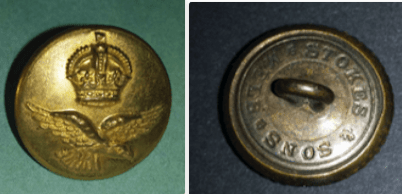
RAAF pre 1952
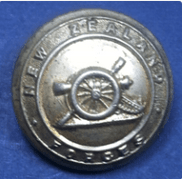
NZ Forces Artillery

NZAF Stokes & Sons.
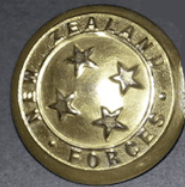
NZ Forces

Auckland Transport Board
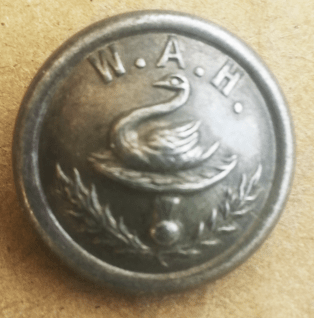
Western Australian Highlanders
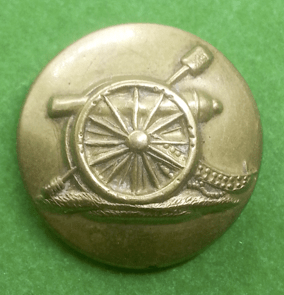
Permanent Victorian Artillery Corps
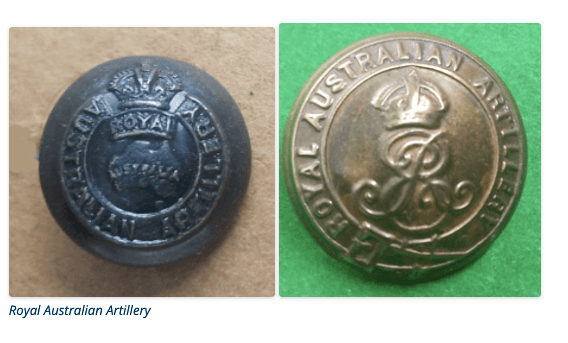
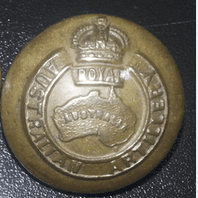
?1930 RAA
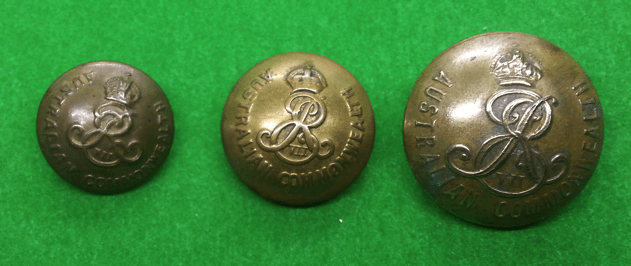
Australian Commonwealth Military Forces
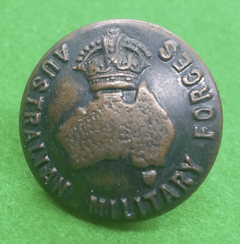
Australian Military Forces
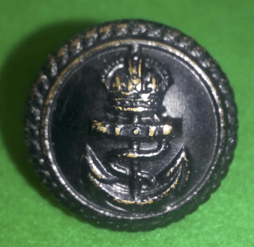
RAN ratings
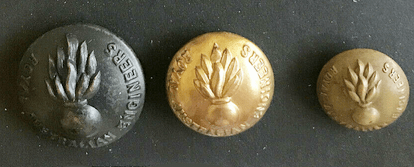
Royal Australian Engineers
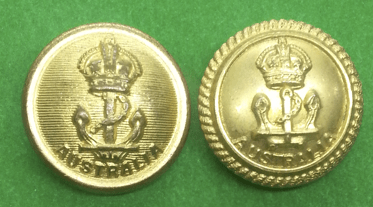
Petty Officers and Chief Petty Officers:Stokes & Sons Melb. Officers (with rope circlet)
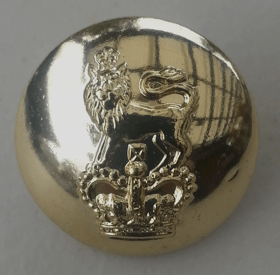
Royal Marines
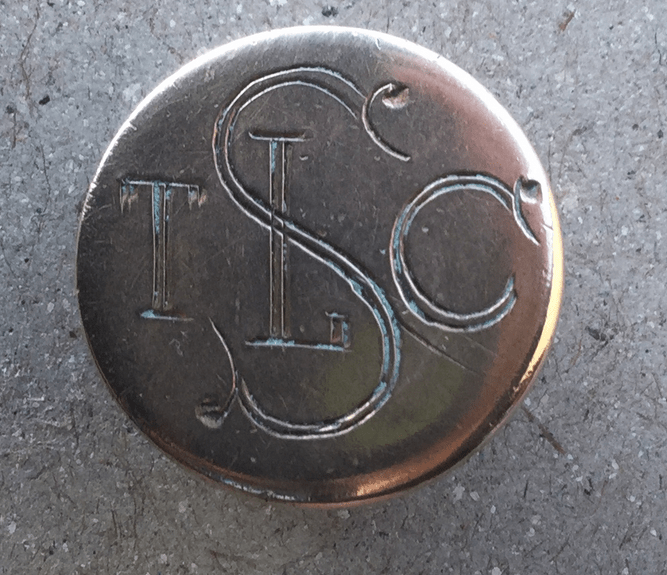
unknown
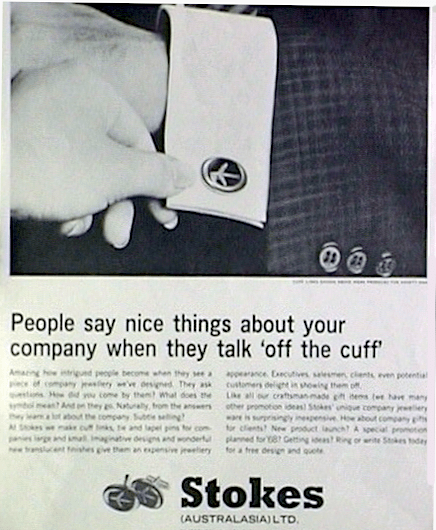
For this image, and others: see the Stokes badges website “About us” section.
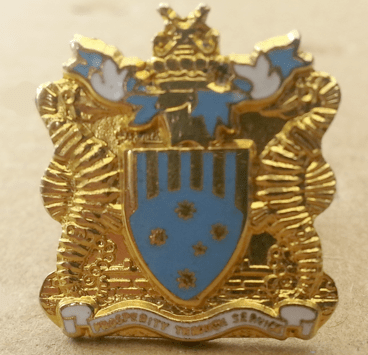
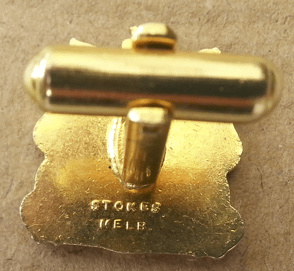
A ‘Melbourne Harbour Trust’ cuff link.
Backmarks/Dating Stokes buttons
Over the years backmarks have been variable, even inconsistent. They have included:
1854-1867: Stokes Maker, T. Stokes
1867-1893: Stokes & Martin, Stokes & Martin Maker
?1893: Stokes Maker, Stokes & Son (unconfirmed)
1893-1935: Stokes & Sons P.O.P. Melb (for Post Office Place)
1900-1915: Stokes & Sons Sydney
c1893-1962: Stokes & Sons
1962-2013: Stokes(A’asia) Ltd, Stokes
Note that anodised aluminum buttons (Staybrite) were produced by Stokes from 1953 according to an article written in 1956. While “& Sons” must date before 1962, on small buttons this was left off due to lack of room even before that date.
